
The Navy Department Library
The U.S. Navy Enlistment, Instruction, Pay, and Advancement
....THE....UNITED STATES NAVY
THE ENLISTMENT INSTRUCTION, PAY AND ADVANCEMENT OF YOUNG MEN
BUREAU OF NAVIGATION, NAVY DEPARTMENT, WASHINGTON, D.C.
1917
PDF Version [21.4MB]
The United States Navy
The life of a sailor, - and particularly the life of a man-of-war’s man, - with its adventures, ever-changing scenes, new countries, new people; following the sea from port to port, from one ocean to another, -has always appealed strongly to the imagination of men of spirit. In the record of the deeds of the men of the United States Navy, from John Paul Jones to Admiral Dewey, the younger American can find the highest inspiration; for the Navy, both in time of war and peace, has played a great, honorable and often glorious part in the history of the country. The Navy has been, throughout its entire existence, a Service of high ideals; and its unbroken record of great and worthy achievement, of duty well-done, has been due to the high standard set for officers and men in the beginning and maintained ever since. This standard was never higher than it is today; and any young American who thinks of going into the Navy may feel sure that, on enlisting, he will enter a service in which he may, and should, always feel a justifiable pride and of which the uniform is a badge of honor.
But, in addition to a chance of serving the country in an honorable position, a place in the Navy offers, as a livelihood, many advantages, -such as steady employment; good, practical training; speedy promotion; provision for old age; a healthful life; an opportunity for travel and education. The pay is graded according to a man’s skill and length of service and compares favorably with that of highly-paid labor in civil life. Indeed, when it is remembered that a blue-jacket’s pay is nearly CLEAR of all living-expenses, it is doubtful that, in ordinary times, there in any class of workmen better paid than the enlisted men of the Navy.
Any young man who wishes to enlist must, of course, come up to the requirements of the Navy, -in character, in physique, in education and in ability. He must earn his advancement; if he is without skill or experience in any trade, he must (and should) be willing to start at the bottom and work up a grade at a time, -as thousands of others like him have done.
__
NOTE-See general index on back cover.
3
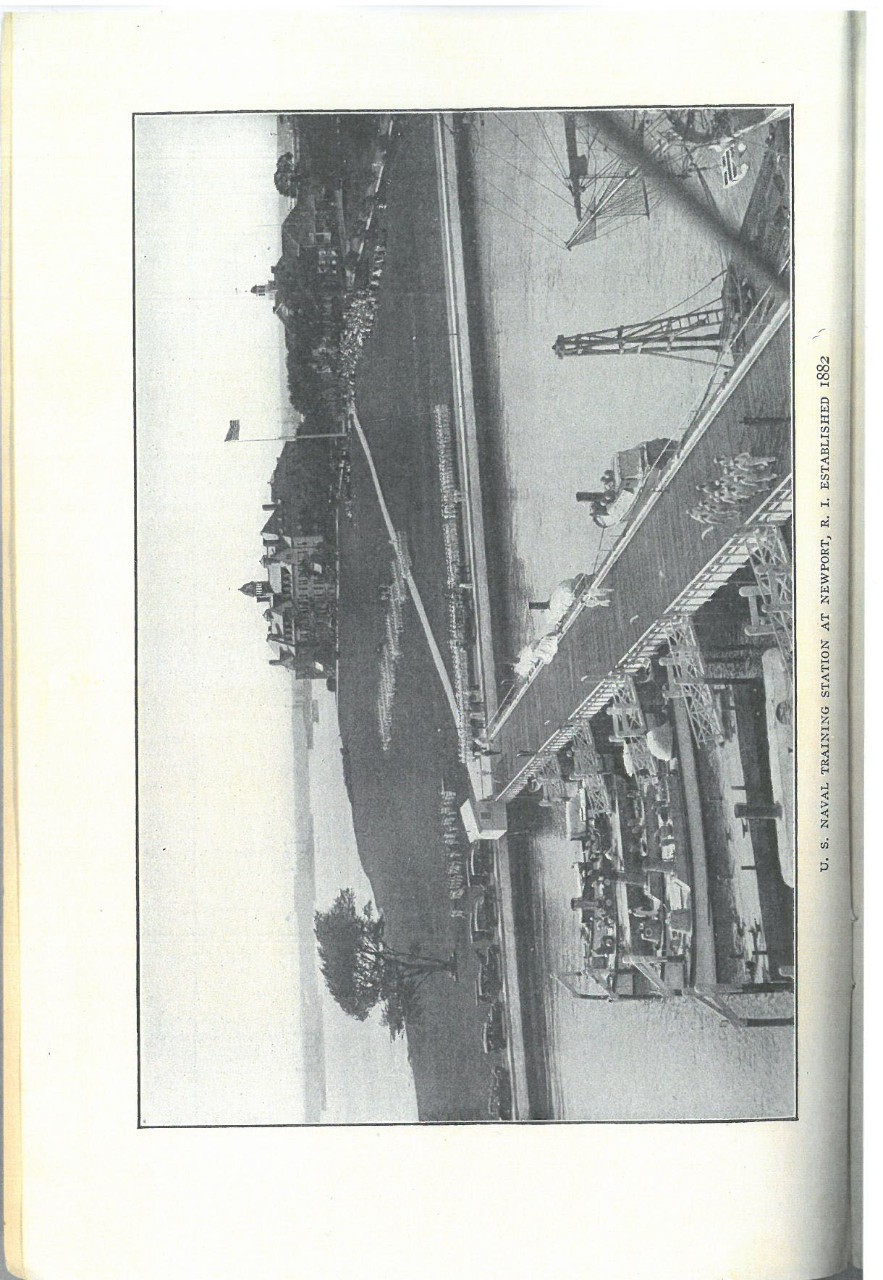
ADVANTAGES OF THE NAVAL SERVICE
STEADY WORK A man-of-war’s man is always sure of his job as long as he renders faithful service and is qualified to perform his duties. He will never lose his job because of strikes or hard times. If he is sick or injured, he is well cared for in a modern naval hospital. His pay goes on whether he be sick or well. He has no doctor-bills for himself. Upon completing an enlistment, if his record has been meritorious, he receives, as a testimonial of fidelity and obedience, an Honorable Discharge; this entitles him to reenlist at any time within four months’ pay as a bonus for reenlisting. If he is disqualified for reenlistment, by reason of disability incurred in line of duty, he is entitled to a pension (explained fully elsewhere in this book).
NAVY FOOD The food in the Navy is excellent. Great care is taken to make sure as to both the equality and the quantity of the sailor’s food. The purchasing, preparing, cooking, and serving is done under the inspection of commissary-officers, who are required to see that the food is appetizing and nourishing. The character of the diet is changed with the seasons of the year and the climatic conditions of the locality in which the ship cruises; but, whenever possible, the sailors are supplied with fresh provisions. It is believed that the U.S. Navy ration is better than that of any other military service in the world.
This subsistence is furnished to enlisted to enlisted men free. They have no board-bill to pay when on duty.
VARIETY OF SCENE Vessels of the United States Navy are employed in all parts of the world, and the opportunities afforded young men travel are very good. While no promise can be made a recruit that he will be given any particular cruise, the duties of the Navy call for frequent foreign cruises; and it is safe to say that, during the course of an enlistment a man will have a chance to visit many out-of-the-way places which he could not possibly visit otherwise without great expense. During the winter months, the Atlantic Fleet assembles in West Indian waters, where drills and maneuvers are held. Men from the battleships go ashore at Guantanamo. Cuba, for target practice on the largest rifle-range in the world. Here other drills are also held, such as artillery practice, shore-signalling, etc. While the fleet is at anchor in Guantanamo Bay, baseball games are played daily, boat races are pulled off in the waters of the bay, minstrel shows are staged and athletic events of all kinds are of frequent occurrence. The ships of the fleet are provided with the latest moving-picture machines and films, and every battleship has its own band.
4
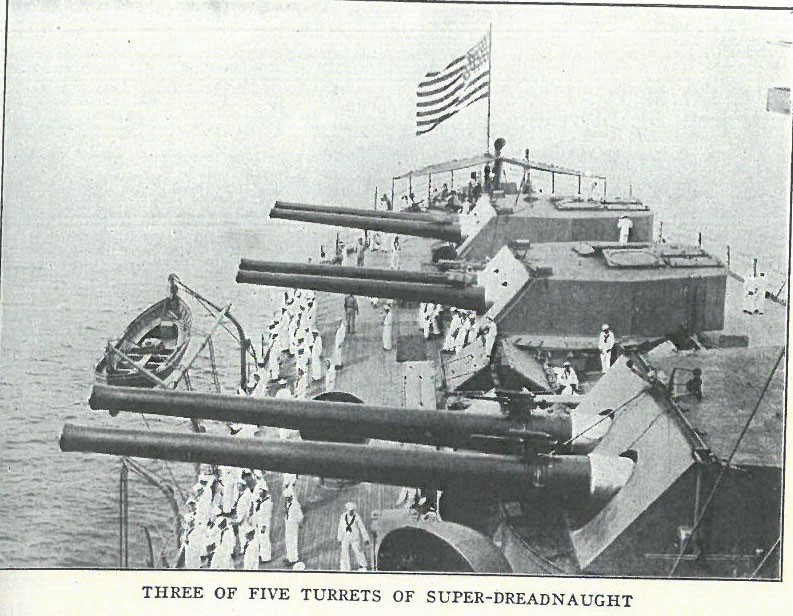
With the approach of Spring the fleet returns north to homeports and liberal shore-leave is granted whenever practicable. During the summer, the fleet maneuvers off the Atlantic Coast of the United States, where war-games are played and target-practice is held.
The men of the Pacific and Asiatic Fleets are similarly employed, and also are given opportunities for recreation like those given men of the Atlantic Fleet.
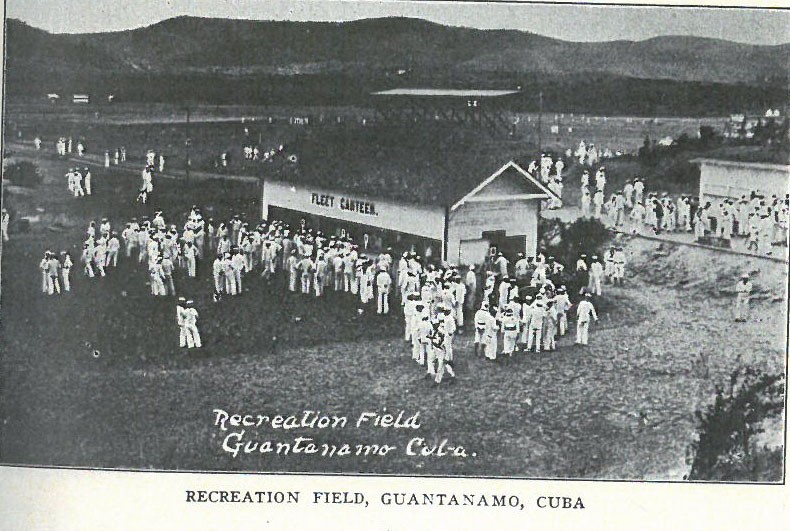
Cruises are made, either by vessels acting singly or in squadrons, to the Philippines, Hawaii and other islands of the Pacific, along the coast of China and to Japan, frequently; to South American, Mediterranean and African ports, occasionally.
NAVY’S EDUCATIONAL SYSTEM The navy maintains numerous schools or the instruction of its recruits. There are four large training stations: at Newport, R.I.; Norfolk, Va.; Great Lakes, Ill., (North Chicago); and San Francisco, Cal. Every recruit who enlists as apprentice-seaman is immediately transferred to one of these training stations for instruction before he is assigned to a seagoing vessel. Young men, between 17 and 25, who are unskilled in any trade are sent to the training stations. The course of instruction is fully described in a separate chapter. For the benefit of men who enter the Navy with some knowledge of or experience in a trade, or special vocation, the Navy maintains trade-schools as follows:
The Navy Electrical School, of the instruction of electricians, both general and radio; the Artificer School, for shipwrights, shipfitters, carpenters, blacksmiths, painters, etc.; the Yeoman School, for stenographers, typewriters, and book-keepers; the Commissary School, for cooks, bakers and commissary-stewards; the Hospital-Corps Training Schools for the instruction of men in nursing, first-aid, drugs, etc.; the Coppersmith School; the Machinist School; the Aeronautical School; the Musician School; the School for Diving; the Torpedo School, and the Class for Instruction in Gasoline Engines.
Not all of these trade schools are open to men on their first enlistment. Some, such as the machinist school and the torpedo school, are open only to men of good record upon reenlistment. All the schools are conducted, however, for the benefit of enlisted men of the Navy who desire to fit themselves for more responsible duty and better pay. In most instances, the training obtained in these schools will stand the men in good stead in civil life, should they decide, after a few enlistments, to remain out of the Navy. Former blue-jackets, who owe their success to the training they received while in the Navy, may be found in nearly every large industry, holding enviable positions.
In addition to the practical instruction imparted at the training-stations and in the Navy trade-schools, a course of academic instruction is conducted throughout the Naval service. Every recruit is examined as to his educational needs and, if he is deficient in any common-school studies, he is assigned to such classes as will supply the education he lacks. He academic instruction does not stop at the training-stations, but continues on board ship; and if a young man shows a willingness to advance himself, he is given encouragement and is afforded an opportunity to demonstrate his ability.
6
PAY AND ADVANCEMENT
When a man enlists in the Navy, his name is immediately placed upon the pay-roll; but if he enlists as an apprentice-seaman, he does not draw all his pay for any month during the training period. However, the pay that is withheld is given him at the time he completes his course of instruction. Thereafter he draws all the pay due him each month. Pay-days in the Navy occur twice a month, -on the 5th and 20th.
CLOTHING-OUTFIT Every recruit is provided free with an outfit of uniform clothing, bedding and other necessaries, amounting to $60.00. This outfit includes among other things, woolen blankets, jack-knife, handkerchiefs, tooth-brushes, hair-brushes, scrub-brushes, shoe-polish, mattress and mattress-covers, neckerchief, high and low shoes, spool of cotton, silk and linen thread; all articles of uniform for summer and winter, including overcoat, sweater, gloves, bathing trunks, and gymnasium shoes. All this outfit of clothing is not issued at once, but only so much of it is furnished the recruit as the season requires; for instances, if he enlists in mid-summer he will be issued white uniform and one set of “blues”. But no overcoat or sweater. If he enters the service in mid-winter, the summer weight or underwear and white clothes will remain to his credit, to be drawn when needed. The outfit is complete in all respects and is ample for the needs of the recruit during his first year of service; and if he is reasonably careful of his clothes, many of the articles need not be replaced for three or four years.
A recruit is taught how to mark his clothes so that they will not be lost. Civilian clothes must be disposed of, and they can either be sent home or given away at the station.
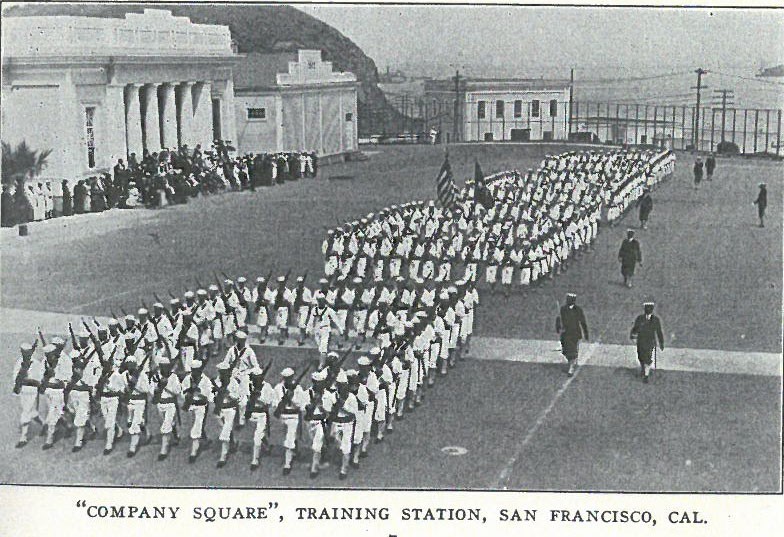
TRAVEL-EXPENSES When a man enlists, he is furnished by the government with transportation to the training-session or to the receiving-ship to which he is assigned; and if there is a night ride, he is given a berth in the sleeper or a stateroom, if sent by steamer. While on the way, meals are furnished by the government, -as are care-fare, transfers across the city, etc. When a man is discharged at the expiration of his enlistment, he is furnished with a “travel allowance,” at 4 cents a mile, instead of transportation, from the place of discharge (if in the United States) to the place of enlistment within the United States. If he is discharged before his enlistment expires, by reason of physical disability, he is furnished with transportation and subsistence to his home, if in the United States. Men travelling under orders are always furnished with transportation and expenses. It is only when a man is travelling at his own convenience, or on leave, that he is required to pay his own expenses.
RATES OF PAY There are many different rates of pay in the Navy; and a man enlisting in one of the lower ratings, is advanced one step at a time, with a corresponding raise in pay, as he becomes proficient and his conduct warrants, -both of which requirements are essential to a man’s advancement in the Navy; and no matter how capable he may be in his duties, he cannot expect to be advanced unless his conduct entitles him to consideration.
The pay of an apprentice seaman is $17.60 a month. The
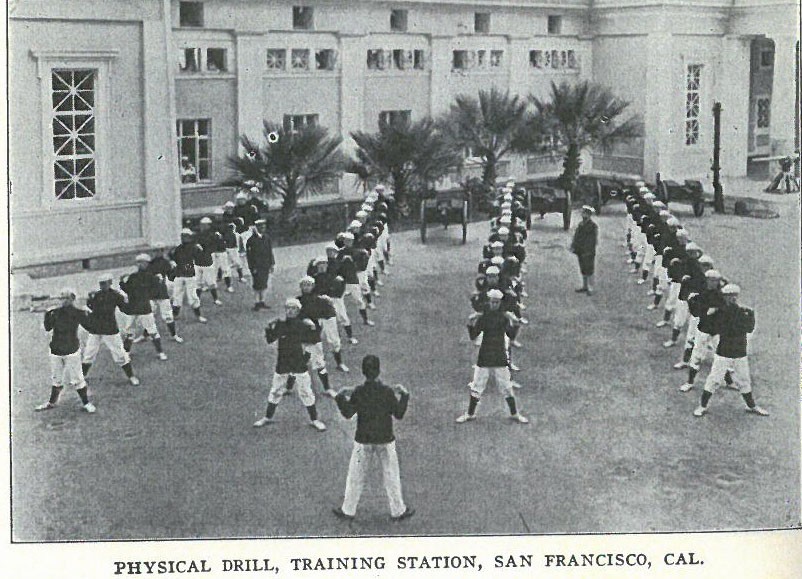
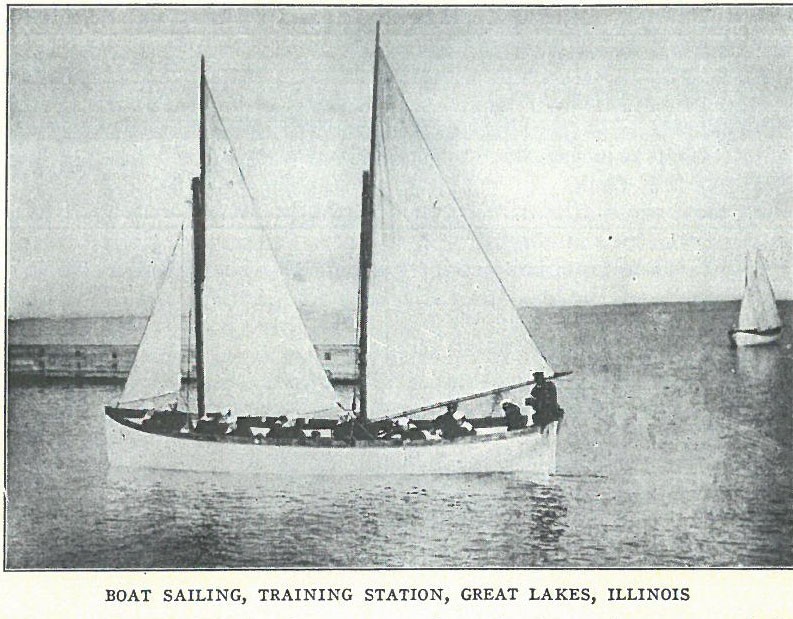
first raise in pay, in the seaman branch, is to $20.90; and in the fireroom, to $24.20. These increases are usually made at the time the recruits qualify at the training station and before they are sent to sea, although apprentice seamen are sometimes sent to a sea-going vessel to complete their training. Subsequent advancement is obtained after the man has been assigned to general service and depends to some extent upon existing vacancies. In the seaman branch, the next rating obtainable on board ship is that of seaman, $26.40. A seaman is eligible for advancement to 3d class petty-officer (coxswain, gunner’s mate, 3d class, quarter-master, 3d class) at $33 per month. Petty officers 2d class, of the seaman branch, are paid $38.50 a month. Petty Officers 1st class are paid $44, except turret captains, 1st class, wo receive $55 to $66 for acting appointment, and $77 for a permanent-appointment, which is issued only after a year’s service as chief petty officer and after examination before a board of officers.
In the special branch, -which includes yeomen, musicians and the hospital corps-the pay ranges from $17.60 and $20.90 for recruits to $77 for chief petty officers with permanent appointment.
The Commissary branch is composed of ship’s cooks, bakers, and commissary-stewards, with pay ranging from $17.60 for the
9
recruit (landsman for cook or baker) to $77 for chief commissary steward.
The messmen branch is composed of men whose duty it is to buy, prepare, cook and serve food for the officers, the ratings being cabin-stewards, cabin-cooks, wardroom-stewards, wardroom-cooks, warrant-officers’ stewards, warrant-officers’ cooks, stewards and cooks for commander-in-chief and for commandants, and mess-attendants, 1st, 2d and 3d class. The pay ranges from $22 a month, for mess attendant 3d class to $66 for stewards to commanders-in-chief.
The pay of the various ratings is set forth in the following tables, this pay being what is known as “base-pay,” or the Navy pay plus 10 per cent increase allowed by law, without allowances for reenlistment, continuous service, good conduct medals or special duty—all of which are explained later:
NAVY PAY TABLE CHIEF PETTY OFFICERS
| Seaman Branch. | Monthly Pay. | Artificer Branch. | Monthly Pay. | Special Branch | Monthly Pay. |
| Chief-masters-at-arms | $71.50 | Chief machinists' mates | $77.00 | Chief Yeomen | $66.00 |
| Chief boatswains' mates | 55.00 | Chief electricians | 66.00 | Chief pharmacists' mates | 66.00 |
| Chief gunners' mates | 55.00 | Chief carpenters' mates | 55.00 | Bandmasters | 57.20 |
| Chief turret captains | 66.00 | Chief water tenders | 55.00 | ||
| Chief quarter masters | 55.00 | Chief Printers | 66.00 | ||
| Chief Storekeepers | 55.00 |
All chief petty officers with a permanent appointment receive $77 a month and allowances.
PETTY OFFICERS, FIRST CLASS.
| Masters-at-arms, 1st class | $44.00 | Boiler makers | $71.50 | Yeomen 1st class | $44.00 |
| Boatswains' mates 1st class | 44.00 | Machinists' mates, 1st class | 60.50 | First musicians | 39.60 |
| Gunners' mates | 44.00 | Coppersmiths | 60.50 | Pharmacists' mates 1st class | 44.00 |
| Turret captains, 1st class | 55.00 | Electricians, 1st class | 60.50 | ||
| Quartermasters, 1st class | 44.00 | Blacksmiths | 55.00 | ||
| Plumbers & fitters | 49.50 | ||||
| Sailmakers' mates | 44.00 | ||||
| Carpenters' mates, 1st class | 44.00 | ||||
| Water tenders | 44.00 | ||||
| Painters, 1st class | 44.00 | ||||
| Printers, 1st class | 44.00 | ||||
| Storekeepers, 1st class | 44.00 |
10
PETTY OFFICERS, SECOND CLASS.
| Seaman Branch. | Monthly Pay. | Artificer Branch. | Monthly Pay. | Special Branch. | Monthly Pay. |
| Masters-at-arms, 2d class | $38.50 | Machinists' mates, 2d class | $44.00 | Yeoman, 2d class | $38.50 |
| Boatswains' mates, 2d class | 38.50 | Electricians, 2d class | 44.00 | Pharmacists' mates, 2d class | 38.50 |
| Gunners' mates, 2d class | 38.50 | Shipfitters, 2d class | 44.00 | ||
| Quartermasters, 2d class | 38.50 | Oilers | 40.70 | ||
| Carpenters' mates, 2d class | 38.50 | ||||
| Painters, 2d class | 38.50 | ||||
| Storekeepers, 2d class | 38.50 |
PETTY OFFICERS, THIRD CLASS.
Masters-at-arms, 3d class |
$33.00 | Electricians, 3d class | $33.00 | Yeoman, 3d class | $33.00 |
| Coxswains | 33.00 | Carpenters' mates, 3d class | 33.00 | Pharmacists' mates, 3d class | 33.00 |
| Gunners, mates, 3d class | 33.00 | Painters, 3d class | 33.00 | ||
| Quartermasters, 3d class | 33.00 | Storekeepers, 3d class | 33.00 |
RATING WITH SEAMEN.
| Seaman gunners. | $28.60 | Musicians, 1st Class | $35.20 | ||
| Seamen | 26.40 | Firemean, 1st class | $38.50 | Buglers | 33.00 |
| Hospital apprentices, 2d class | 20.90 |
RATING WITH SEAMAN, SECOND CLASS.
Seamen, 2d class |
$20.90 | Firemen, 2d class | $33.00 | Musicians, 2d class | $33.00 |
| Shipwrights | 27.50 | Buglers | 33.00 | ||
| Hosptial apprentices, 2d class. | 20.90 |
RATING WITH SEAMEN, THIRD CLASS.
Apprentice seamen |
$17.60 | Firemen, 3d class | $24.20 | Landsmen | $17.60 |
COMMISSARY BRANCH.
| Monthly Pay. | Monthly Pay. | ||
| Chief commissary stewards | $77.00 | Ship's cooks, 4th class | $27.50 |
| Commissary stewards | 66.00 | Bakers, 1st class | 49.50 |
| Ship's cooks, 1st class | 60.50 | Bakers, 2d class | 38.50 |
Ship's cooks, 2d class |
44.00 | Landsmen | 17.60 |
| Ship's cooks, 3d class | 33.00 |
11
MESSMAN BRANCH.
| Monthly Pay | Monthly Pay | ||
| Stewards to Commanders in Chief | $66.00 | Steerage stewards | $38.50 |
| Cooks to Commanders in Chief | 55.00 | Steerage cooks | 33.00 |
| Stewards to Commandants | 66.00 | Warrant officers' stewards | 38.50 |
| Cooks to Commandants | 55.00 | Warrant officers' cooks | 33.00 |
| Cabin stewards | 55.00 | Mess attendants, 1st class* | 33.00 |
| Cabin cooks | 49.50 | Mess attendants, 2d class* | 27.50 |
| Wardroom stewards | 55.00 | Mess attendants, 3d class* | 22.00 |
| Wardroom cooks | 49.50 |
*If American Citizens.
All stewards and cooks of the messman branch who are American citizens, and hold certificates of qualification, receive $5.50 a month in addition to the above rates of pay.
ALLOWANCES FOR REENLISTMENT In order to obtain all the benefits of Continuous service, a man must reenlist within four months after the date of his honorable discharge. He can reenlist the next day, or remain out of service for four months; but if he reenlists within four months, he receives a bounty of 4 months’ pay at the rate he was paid on discharge. Upon reenlistment, his pay is increased by $1.50 for honorable discharge. In addition, and as a compensation for a trained man and regardless of whether or not his service is continuous, his pay is increased by a further sum of $5.50 per month for the first reenlistment, and by $3.30 per month for each subsequent reenlistment.
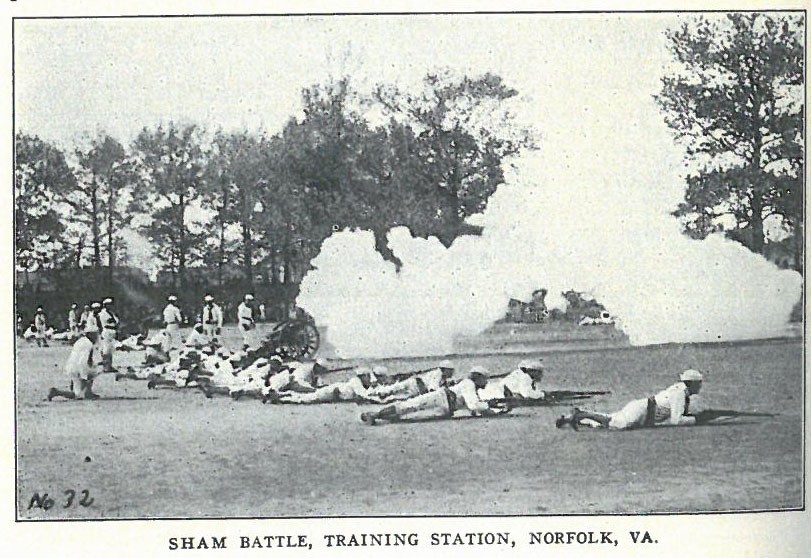
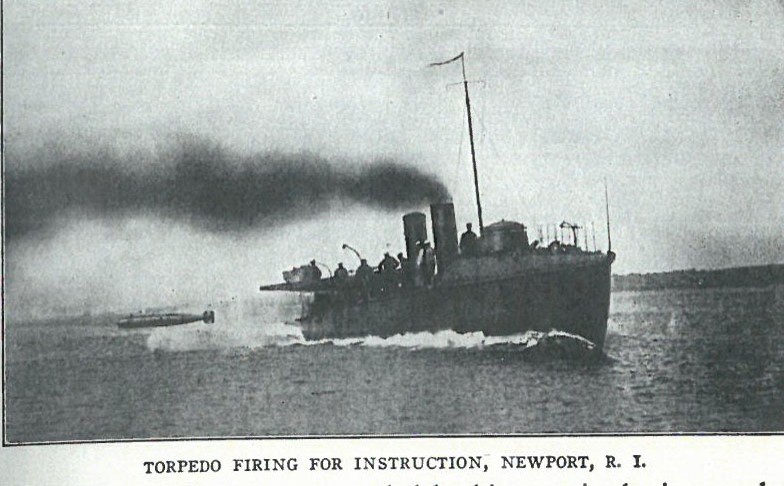
Further, if he is recommended by his captain, he is awarded a good conduct medal, after the second enlistment and a good conduct bar on each subsequent reenlistment. The holder of a good conduct medal, pin or bar is entitled to 82 cents a month for each medal, pin or bar he possess, for all his subsequent enlistments that are continuous. These payments accumulate with each enlistment. Thus it will be seen that, on second continuous enlistment, the pay of any rating or branch of the service is increased by $7.00 per month; on the third enlistment, the pay is further increased by $5.62, and so on through his naval service career.
Men who enlist within four months from the date of their honorable discharge may, under certain conditions, be detailed to a course of instruction in the Seaman-Gunner’s School. A certificate of graduation from this school entitles the holder to a $2 a month additional to his pay.
Men of the fireroom in the ratings of water-tender, oiler, and fireman first class, not over 30 years of age, who have served one creditable enlistment and reenlisted within four months, and who are recommended by their commanding officer, can be sent to the Machinist’s Mates School.
ALLOWANCES FOR SPECIAL DUTY Coxswains of boats propelled by machinery, coxswain to commanders-in-chief, seamen in charge of holds, men regularly detailed as crew messmen, men assigned to duty as jack-of-the-dust and as lamp-lighter, all receive $5 a month in addition to their other pay.
Apprentice seamen who are detailed as apprentice petty officers in connection with the instruction of apprentice seamen at Naval Training Stations, receive additional pay while so detailed as follows: apprentice chief petty officers $2.50; apprentice
13
petty officers first class $2.00; second class $1.50; third class $1.00 each per month. The complement of apprentice petty officers is 4 (one in each rating) for each 75 apprentice seamen under training.
Chief petty officers detailed as instructors of apprentice seamen at training stations receive $10.00 a month extra for this special duty.
Enlisted men regularly detailed by the commanding officer as gun captains, excepting secondary-battery guns, shall receive in addition to their pay $5.00 a month.
Men regularly detailed as signalmen shall receive extra compensation per month as follows: signalmen, first class, $3; second class, $2; third class, $1.
Enlisted men who are detailed for aviation duty as student aviators or student airmen, received 50 per cent increase in pay and allowances, of their rating.
Five dollars a month is allowed each man serving on board a submarine vessel, in addition to his regular to his regualar pay. He is besides allowed $1 additional for each day the submarine is submerged while under way, provided it does not amount to more than $15 in any one month.
A man employed in submarine diving, and not under instruction or diving for practice, receives extra pay at the rate of $1.20 an hour for the actual time so employed under water.
Enlisted men who qualify as gun-pointers and who are regularly detailed by the commanding officer receive the following additional monthly pay:
Heavy-gun pointers (for guns od 8-inch caliber or larger):
First class $10
Second class 6
Intermediate-gun pointers (for 4-inch to 7-inch guns):
First class 8
Second class 4
Secondary-gun pointers (for guns from 1-pounder to 3-inch):
First class 4
Second class 2
Gunnery prizes are awarded to the members of meritorious gun and torpedo crews in three classes, viz: First class, $20; second class, $10; and third class, $5 per man. The members of winning turret, gun and torpedo crews are also awarded the right to wear the Navy “E”, signifying “Excellent”.
An enlisted man detailed as “ship’s tailor” on board a vessel having a complement of 600 men or more, exclusive of marines, shall receive $20 per month in addition to the monthly pay of his rating; on a vessel having a complement of 300 to 600 men, $15 per month additional; on a vessel having a complement of 600 men or more, receives $10 per month in addition to his monthly pay: Provided, That the total pay of
14
“ship’s tailor” shall not exceed $50 per month, and of “tailor’s helper” $40 per month.
Men detailed as Navy mail clerks receive in addition to their other pay $30, $25, $20 and $10 a month, depending upon the size of the crew of the vessel or flotilla. Men detailed as assistant Navy mail clerks receive $15 a month in addition to the pay of their rating.
APPOINTMENT TO NAVAL ACADEMY The law provides for the appointment each year of 100 enlisted men to the Naval Academy, the requirements being that the applicant must pass a competitive examination, must be under 20 years of age at the time of appointment, and must have been in the Navy at least one year at date of entrance to the Naval Academy. Examinations for entrance to the Naval Academy are conducted on board all ships and stations wherever there are applicants. In order to give young men a chance to prepare for this examination, classes are formed at all the training stations (and on board ships), with special instructors and the free use of the necessary text-books. The candidates who have the highest standing on the examination, and have successfully passed the physical examination, enter the Naval Academy on August 15th, and are admitted on exactly the same terms as midshipmen who are nominated by Members of Congress.
PROMOTION TO WARRANT OFFICER Advancement in the Navy does not stop with chief petty officer. The next higher grade is that of warrant officer which is a life position attainable only by promotion from enlisted grades. The pay of a warrant officer is from
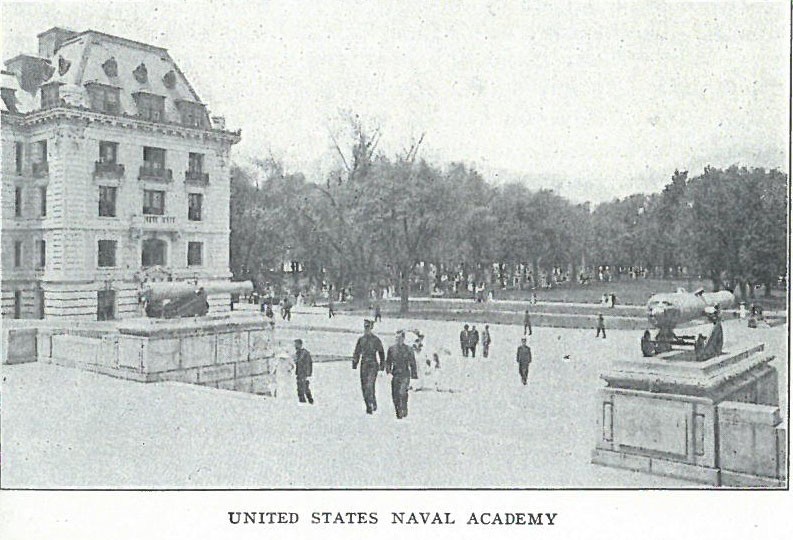
$1,500 to $2,400 a year depending upon length of service, with benefits of retirement at 64 years of age on three-quarters pay, or at any time before 64 for disability incurred in line of duty. The warrant officers’ grade is composed of boatswains, gunners, carpenters, machinists, pharmacists and pay clerks. The qualification for appointments are as follows:
Boatswains are appointed from among candidates of the seaman branch under 35 years of age, who have served at sea at least seven years, have attained the rating of chief or first-class petty officer, with an average mark on their enlistment record of not less than 85 per cent and are serving continuously.
Gunners are divided into three class: Ordnance, electrical, and radio. Candidates must be under 35 years of age, with an average mark of not less than 85 per cent, and serving as chief or first class gunner’s mates, turret captains, or electricians.
Carpenters are appointed from among candidates of the artificer branch, under 35 years of age, with an average mark of more than 85 per cent, and serving continuously as chief or first-class petty officers.
Pharmacists are appointed from among chief petty officers of the hospital-corps of the Navy who have served at least three years as enlisted men, two years of which must have been spent on board a cruising vessel, preference being given to men who have been honorably discharged and whose service is continuous. The average service mark must be not less than 85 per cent. While there is no age limit fixed, their possible future service prior to attaining the age 64, plus accumulated service in the Navy, Army and Marine Corps, must amount to at least 30 years.
Pay Clerks are appointed from among chief petty officers of the Navy, who have served at least three years as enlisted men, two years of which have been on board a cruising vessel.
ADVANCEMENT OF WARRANT OFFICERS Warrant Officers are commissioned as Chief Warrant Officers in their various grade, with rank of Ensign, after six years’ service as boatswain, gunner, carpenter, machinist, pharmacist or pay clerk.
After six years’ further service from date of commission they receive the pay and allowances of a lieutenant junior grade in the Navy; and after twelve years’ service from date of commission they receive the pay and allowances of a lieutenant in the Navy.
16
WINNING A COMMISSION IN THE NAVY The advancement which is open to ambitious young men who enlists in the Navy is not limited to the grade of warrant officer. There are several avenues open promotion to commission; for example:
A boatswain, gunner or machinist, or a chief boatswain, chief gunner, or chief machinist, who has been his grade four years and is under 35 years of age, may enter the examination for appointment as ensign; this examination is held every year, appointments being limited to12 annually. A man who wins a commission in this manner is entitled to the same pay, privileges, honors and opportunities for further advancement as are open for officers who are graduates of the Navy Academy.
Pay Clerks and chief pay clerks under 35 years of age may take the examination for appointment as assistant paymaster in the Navy. This examination is usually held each year and is competitive.
The young men who are appointed to the Naval Academy in accordance with the examinations previously described, will, upon graduation, be given commissions in the Navy.
DEATH BENEFITS Men who die in the service from wounds or disease not the result of their own misconduct will have an amount equal to six months’ pay immediately paid to their widow, children, or other dependent relatives previously designated by them. No deduction is made for interment, or expenses for preparation and transportation of the remains. In the cases of men engaged in aviation duty who die because of wounds or disease resulting from an aviation accident, the amount paid the widow or family will be equal to one year’s pay.
SAVINGS The privilege of depositing savings of $5 and upward with the Navy paymaster is allowed all enlisted men. These savings draw 4 per cent straight interest on the money deposited. Pass-books are issued, as in a savings bank, but the money cannot be drawn until the men are discharged.
SENDING MONEY HOME Money-orders may be obtained from the mail clerk board ship to send home or to a savings institution. Men serving at sea, or on a foreign station, may register an allotment for the support of their families or for their own savings. This money will be paid each moth (by Government check) from the allotment-office in Washington, no matter in what part of the world the man may be serving, and will continue as long as the allotment is registered.
PAY CONTINUES THROUGH SICKNESS In the naval service, a man’s pay goes on just the same, sick or well, and he has the free benefits of skillful medical attention, trained nurses, medicine, and well-appointed hospitals.
17
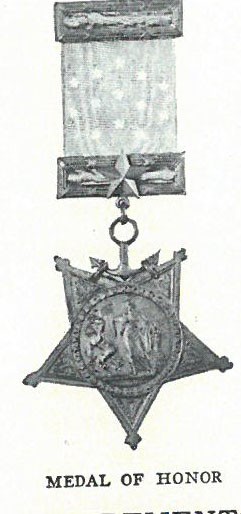
REWARD FOR DISTINGUISHED SERVICE Any listed man who distinguishes himself in battle or displays extraordinary heroism in the line of his profession shall, upon the recommendation of his commanding officer, approved by the flag officer (admiral) and the Secretary of the Navy, receive a gratuity of $100 and a medal of honor. In addition, he may be promoted to warrant-officer, if recommended and found qualified.
Gold life-saving medals may be awarded to those in the Navy who may have, by extreme and heroic daring, endangered their lives in saving or endeavoring to save lives from the perils of the sea inwaters over which the United States has jurisdiction, or upon an American vessel; silver life-saving medals may be awarded in cases not sufficiently distinguished to deserve the gold medal.
Other deeds of heroism are rewarded by commendatory letters from the Secretary of Navy; these are read at general muster and are attached to the man’s record.
Campaign medals and badges are issued for meritorious service in which a large number of men participate, such as the Philippine Insurrection, the Chinese Expedition, the Nicaraguan Campaign, and similar Campaigns.
RETIREMENTS AND PENSIONS Any disabled person who has served as an enlisted man in the Navy for ten years, and has not been discharged for misconduct, may apply for aid from the surplus income of the Naval pension fund, which may be granted upon the recommendation of a board of not less than three Naval officers in “suitable amount,” to be approved by the Secretary of the Navy. This service pension is in addition to a disability pension under the general law, which may be allowed him by the pension office.
When an enlisted man is disabled by reason of any injury received, or disease contracted, in line of duty as the result of an aviation accident, while employed in actual flying or in handling aircraft, the amount of pension is double that authorized for other accident the pension allowed to his family is double that allowed under other circumstances.
After twenty years of service any enlisted man disabled from sea service by reason of age or infirmity and who has not been discharged for misconduct shall, if he so elects, be entitled to a pension equal to half pay, or be admitted into the Naval Home, Philadelphia, Pa.
18
Any enlisted man who served thirty years may be placed upon the retired list a three-fourths of his pay, with additional allowances, amounting to $15.75 a month, for rations, quarters, fuel, and light. All service in the Navy, Army, or Marine Corps is credited for retirement.
THE NAVAL RESERVE A naval force has been authorized consisting of six classes: first, the Fleet Naval Reserve; second, the Naval Reserve; third, Naval Auxiliary Reserve; fourth, Naval Coast Defense Reserve Flying Corps.
The first class, or the Fleet Naval Reserve, is composed exclusively of ex-officers and ex-enlisted men of the Navy who have left the service under honorable conditions and who are citizens of the United States. Men who have served one enlistment of the United States. Men who have served one enlistment creditably and receive an honorable discharge may enroll in the Fleet Naval Reserve with pay at the rate of $50.00 per annum. Hose with between eight and twelve years’ naval service may enroll with pay at $72.00 per annum. Those with twelve or more years’ naval service enroll with pay at $100.00 per annum.
Men who have served in the Navy for sixteen years or more may transfer to the Naval Reserve at one-third of their base pay plus all permanent additions thereto; and men with twenty years’ service or more many transfer to the Reserve at one-half their base pay plus all permanent additions thereto. In addition to these rates of pay men who enroll in the Reserve received an increase of twenty-five per cent for each re-enrollment. It is required of them, however, that they shall serve at least three months on active duty during each four-year period and re-enroll within four months. Men who transfer with sixteen or twenty years’ active service are allowed a further increase of ten per cent for extraordinary heroism in line of duty; and those with twenty years’ active service are given a further credit of ten per cent, provided their average marks in conduct for twenty years or more shall be not less than ninety-five per cent of the maximum.
Men transferred to the Fleet Naval Reserve may, upon completing thirty years’ service, including active and reserve, be retired with the pay they are then receiving plus the retired allowances described in the preceding section. Men who enroll in the Reserve and receive in lieu of their pay a cash gratuity equal to the total amount of their pay during the last term of their enrollment.
Members of the Fleet Naval Reserve may be examined for warrants commissions in the Reserve. Men who enroll in the Reserve with four, eight or twelve years’ active service are given a clothing allowance each enrollment amounting to $30.00,
19
which amount is increased to $60.00 in time of war or national emergency.
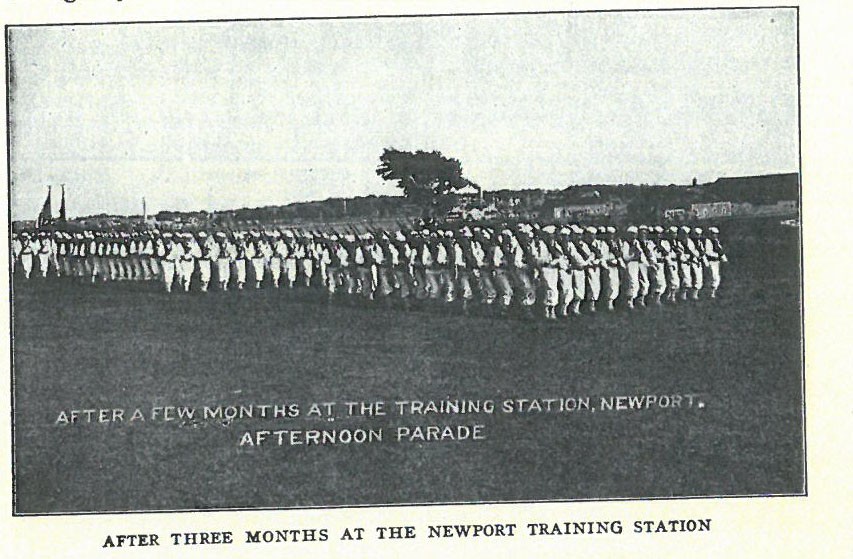
HOW THE NAVY TRAINS ITS YOUNG MEN
Young men between 17 and 25 who are not skilled in any Navy trade are enlisted as apprentice seamen. Immediately upon being sworn in at the recruiting station, they are sent, at government expense, to a naval training –station.
FIRST THREE WEEKS Upon arrival at a naval training-station, the recruit is admitted to the detention camp, or “recruits” barracks,” as it is known at some training-stations, where he remains at least three weeks. During this time he is kept under observation in order to make sure that he has brought no contagious disease, which might be spread to the entire brigade. The recruit’s instruction, however, begins when he enters the recruit-barracks. He is assigned to a company commanded by a chief petty officer specially selected for duty as instructor, and the recruit remains a member of this company, with the same instructor, during his entire training course, unless he is “put back.” His company leaves this recruit-barracks for the main barracks or camp, intact, and remains intact until the instruction is completed, and the men are promoted.
PRELIMINARY INSTRUCTION At the recruit-barracks, or detention camp, the recruit is given preliminary instruction. He is taught “personal cleanliness,” –how to care for his body, how to scrub and wash his clothes, how to
20
Mend torn clothing, and, in short, how to “look after himself.” He is sent to the dentist who examines his teeth to ascertain whether or not there is any work required and, if so, it is done free of charge, except the cost of the material, when gold or silver is used. He is interviewed by the chaplain who, in a kindly manner, questions him regarding his previous life, his occupation, his religious affiliations, and counsels the men in morals in spiritual affairs and in their duties to themselves and their associates and to the government they are serving. At some stations the chaplain is placed in charge of the academic instruction. The recruit is examined as to his knowledge of common school studies and is assigned to classes similar to the grades in the public schools. The academic studies are compulsory and continue throughout the whole period of training.
AFTER THREE WEEKS After the required three weeks in the recruit-barracks or camp, the company is transferred to the main barracks, where the course of instruction is extended. The time spent at the detention-barracks is well employed; and the confinement there is not onerous, as the civilian might assume. The recruits’ camp has its own drill and athletic field and wholesome exercises are encouraged, moving-picture shows are given frequently, and other entertainments are provided for the benefit of the boys who have just arrived from home and who are not granted leave.
MAIN BARRACKS The course of instruction at the four training stations is similar in scope and principle but differs in detail; for instance, the open-air drills are continued for a greater period of the year at the training stations at Norfolk and at San Francisco than at Newport and Great Lakes. Another difference is that at Norfolk the recruits are quartered in bungalows, arranged in company streets that is, a street or small thoroughfare is assigned to each company. Each bungalow accommodates six men, who sleep in hammocks and whose clothing is kept in canvas bags suspended from iron jack-stays. The bungalows are lighted by electricity and heated by steam. The lower portion of the sides is formed of ordinary weather boarding; the upper provided with a canvas screen, which can be laced down in bad weather and rolled up in good weather. This forms practically perfect ventilation in good weather and makes it possible to keep the bungalows warm and snug when the weather is inclement. The floor of each bungalow is raised about eighteen inches from the ground and is, in this way, kept dry and clean underneath. The bungalows furnish the living quarters for the apprentice seamen. The mess halls, reading rooms, libraries, sick-quarters, and other necessary places are provided for in adjacent buildings. At Newport, at Great Lakes and at San
21
Francisco, the men are quartered in barracks, large, airy and modern buildings, well lighted, well ventilated and well heated.
DAILY ROUTINE The days are well taken up with drills, duty and study periods, but ample time is left for recreation, amusements and athletics. The work is varied and interesting and consists of drills in artillery and infantry; target practice with rifle and revolver; signaling; physical drills in the gymnasium with the Swedish system of exercises; swimming; elementary seamanship, including knotting and splicing; and handling boats under both oars and sails. For part of the time in the summer months the recruits camp out and are given practical experience in military work of a field detachment, including trench digging, etc. They also take occasional hikes, and conduct sham battles. The drills are held daily excepting Saturdays, Sundays, and holidays. The daily routine at Norfolk is given as an example:
The bugler sounds reveille at 5:00 a.m. when all must turn out and be ready for muster at 5:30. From 5:30 to 7:00 a.m. the recruit is engaged in cleaning himself, his clothes and the camp. Breakfast hour is over at 8:00 and from that time until 3:15 in the afternoon the time is divided into periods for drills, studies and instruction. Extra periods of drill are held after 3:15 for boys who cannot swim and for those wo either are deficient or are required to perform extra duty. Otherwise, the time until 6:00 p.m. is devoted to athletics and amusements. Dinner is served at 12:00 and supper at 6:00. Between 7:00 and 8:00 p.m. there is a school for those who are delinquent in their studies, and once a week singing-school is held. All are required to be in their hammocks at 9:00 p.m., except when there is a smoker or special entertainment at the station, or the men are on leave overnight.
On Saturday and Sunday the routine is varied as follows: Saturday, ---Assembly at 9:00 a.m. followed by Captain’s inspection. Bag inspection at 10:30 to 11:30. From 1:00 p.m. liberty is granted, liberty parties leaving every hour. Sunday, --Church call at 8:30 a.m., first call for Catholic Church party. Protestant Church party at 10:15. From 1:00 p.m. liberty is granted.
This routine is sometimes varied, depending upon circumstances; for the need of the Navy for men to man ships, occasionally makes necessary the shortening of the instruction period at training-stations. In such instances, the training is continued after the apprentice seamen are promoted and transferred to ships.
SPECIAL INSTRUCTION Recruits who show special aptitude for signaling or for wireless telegraphy, are assigned to classes for advanced instruction in
22
either of these branches. Apprentice seamen who show sufficient expertness as radio operators and can qualify in their test may be sent to the Electrical School at New York for a more complete course of instruction in radio before being assigned to general duty.
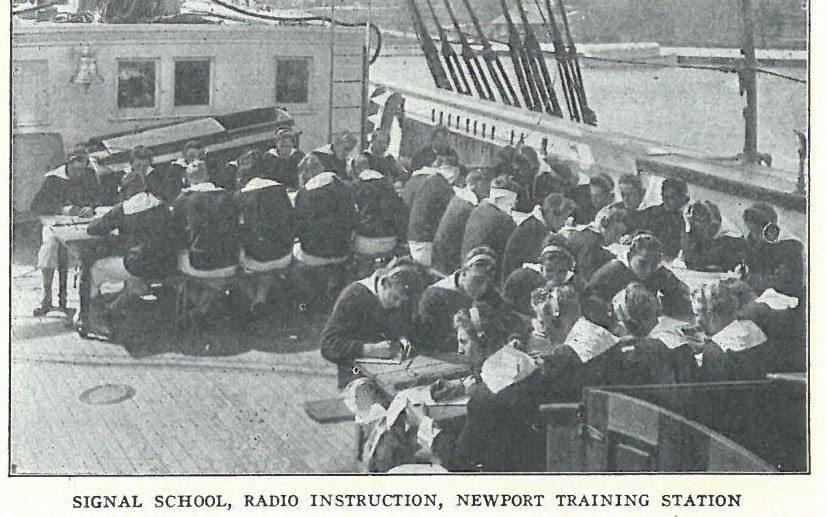
An apprentice seaman who shows aptitude in music may similarly be assigned to the Musicians’ School for practical course or instruction to fit him for duty in a Navy band.
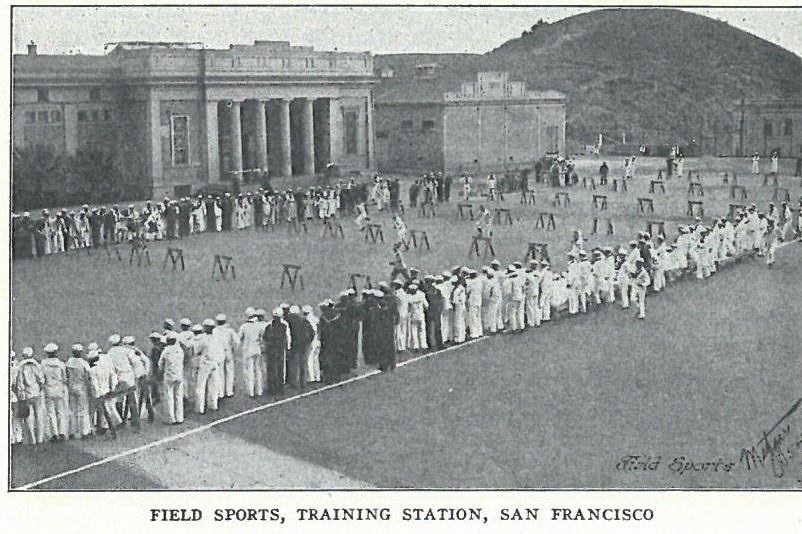
Any young man undergoing the apprentice training course who displays aptitude for a particular rating, such as coppersmith, carpenter, shipfitter or yeoman, will have a notation to that effect made upon his record as evidence that he possesses such qualifications; and, after he has served some months at sea on a cruising vessel, he may, if conditions permit, be detailed to one of the trade-schools hereinafter described.
RECREATION The Training Stations afford ample opportunities for wholesome recreation. Athletics receive every encouragement. Each company has its own baseball, football, basketball and track teams, as well as boxers, swimmers, etc. One afternoon of each week is set aside for athletic events. Many interesting inter-company contests are held, and the competition is very keen for the trophy which is awarded to the company making the best showing. The Training Station has excellent baseball, football and basketball teams, which engage in contests with the crack organizations of surrounding town and cities.
LIBERTY AND SPENDING MONEY Leave, with permission to visit the nearby, cities, is usually granted twice a week to apprentice seamen of the main barracks, excepting those who may be restricted as punishment, for violation of rules. Apprentice seamen are allowed to draw only $4.00 a month in two monthly payments, the balance remaining to their credit until they complete their training course, thus providing an ample fund for them to go on furlough to visit their homes.
MORAL AND RELIGIOUS INFLUENCES Every endeavor is made to maintain at the training stations a moral atmosphere which shall surround the apprentice seamen at all times. The officers and chief-petty-officer-instructors are required to set good examples of clean and honorable living and to demonstrate the fact that such living is necessary to success in the Navy as well as in civil life. No profane or obscene language is tolerated and punishment therefor is more certain than for other offenses. Attention is given to moral hygiene, and three lectures on this subject are delivered to each company; one lecture being by a line officer who treats the subject from a professional and service standpoint; and one by a chaplain from a professional and service standpoint. Navy Y.M.C.A.’s have organizations within the training stations and their influences are wielded for both the physical and moral benefit of the recruits. There is a chaplain attached to every training station and religious services are held every Sunday. Recruits who desire to attend religious services of any denomination other than that of
24
the chaplain, are permitted to visit the church of their choice outside the station.
FINAL EXAMINATIONS AND TRANSFER After the apprentice seaman has completed his course of instruction, he is examined; and, if he is found qualified, he is advanced in rating, is allowed to draw the money due him, and, if his conduct warrants, is given leave to go home. The course at the training station has performed wonders and he appears quite a different person from the recruit received at the station a few months before. He is erect, alert and athletic, well-developed, keen to learn and ready to obey. The training-station has done all that it can for him and his future progress rests almost entirely with himself. After returning from leave, he will be sent on board a cruising vessel (wherever his services are needed) and he will be received in a spirit of sympathy and encouragement, - for his new shipmates have all been “through the mill” and, like himself, had much to learn when they were sent to a man-o’-war.
NAVY TRADE SCHOOLS
The Navy requires men of many different trades and of varied knowledge to operate its vessels and to perform all the intricate work required by a naval establishment. In order that young men who enter the Navy in the subordinate ratings may become proficient, various trade-schools have been established. These trade schools are separately described in the following paragraphs.
When a man who enlist claims to have a trade, the recruiting officer is instructed to make an entry to that effect on his service record. This service record follows the man throughout his enlistment. Similarly, when recruits at the training stations demonstrate that they possess a trade, the commanding officers of the training stations are required to make like notation on their records. This is done so that, when the newly enlisted man arrives on a sea going vessel, his commanding officer will have a knowledge of any special qualifications he may possess, and will, when practicable, give the man an opportunity to qualify for duty in that trade. The Navy desires to encourage men in general service to qualify for trades.
NAVY ELECTRICAL SCHOOLS Electrical schools are located at the Navy Yard, Brooklyn, N.Y., and the Navy Yard, Mare Island, Calif. The schools are divided into two classes, general and radio. The length of the course for both classes is eight months; and students, either recruits or men from general service, may enter at any time.
In order that a recruit may enlist for the electrical branch, he must have a knowledge of either general electricity, or be an
25
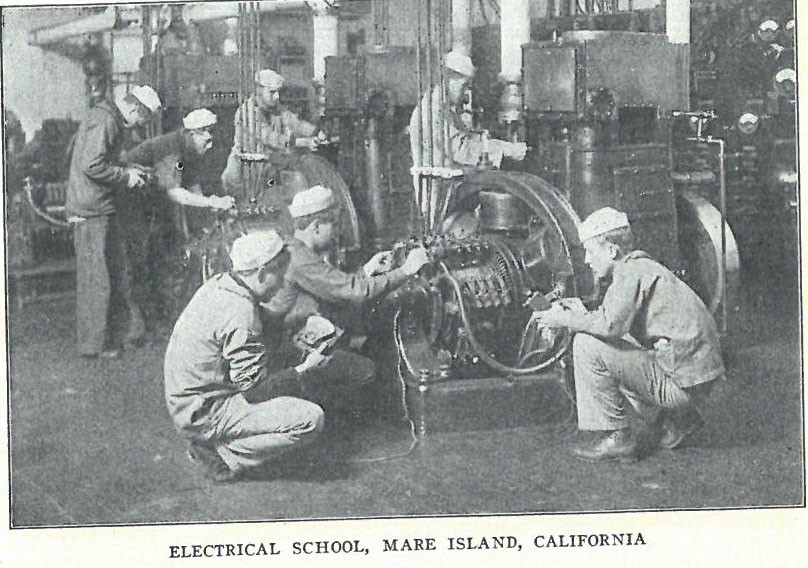
operator of the Morse telegraph code or have sufficient foundation in radio telegraphy to be competent to keep up with the class at the school. Electricians (general) must know the names and uses of the various parts of the dynamo and dynamo engine and must be familiar with the ordinary types of switchboards and methods of wiring. Applicants for both classes must be able to write legibly, must understand elementary arithmetic and must be between the ages of 18 and 25. Applicants for the radio branch must, in addition, pass a creditable examination in spelling and penmanship; and the requirements in arithmetic include multiplication, division, simple proportion, percentage and square root. Testimonials as to good character and skill as an operator must be presented by the candidate, either from former employers or from the principal of a trade school where the candidate has been a student in either telegraphy or radio. He must be able to receive 20 words per minute.
Such recruits are immediately transferred to the electrical school, where the course of instruction comprises machine-shop work, reciprocating steam-engines, steam-turbine engines, internal-combustion engines, magnetism and electricity, dynamos, motors, motor-generators, alternating currents, batteries, etc. Members of the radio class are trained in all the duties of a radio-operator and are given constant practice in the use of the mechanism employed in radio and in receiving and sending.
ARTIFICER SCHOOL This school is located at the Navy Yard, Norfolk, Va., and is
26
composed of classes for shipwrights, shipfitters, blacksmiths and painters. The shipfitter class also includes the duties of plumber and fitter. The length of the course is three months for each class excepting that for shipfitter, which is six months. Recruits are admitted to the various classes of the artificer school, provided they know some one of the trades mentioned well enough to pass the examination, for the course of instruction is not elementary and requires previous knowledge of and aptitude for the trade. Men are permitted, however, to enter the artificer school, if specially recommended by their commanding officers after examination on board ship.
An applicant for the shipfitter class should have had experience as a metal worker, be able to lay out work; know how to chip and calk and drive rivets; understand the various rules for drilling and tapping; have some knowledge of pumping and drainage and be familiar with the required tools and their uses and care. Applicants for the shipwright class should have some practical experience in carpentry, know the names of the tools used, etc. The instruction is along the same line as for shipfitter, with the addition of cooperage, joiner-work, repairing boats, spas, oars, etc., calking seams in wooden decks and cutting threads on bolts with hand dies.
For the blacksmith class, a candidate must have had some experience at the trade. He is taught welding in different ways, “jumping on” pieces, working angle-iron, making shackles, chain, bolts, rivits, mast-bands, eye-bolts, pad-eyes, iron-work for blocks and all the fittings likely to be required on board ship which would have to be made with a forge. Blacksmiths are also given special instruction in shackling and unshackling chain.
A candidate for painter must have had some experience as a painter and must know the rules for mixing paint and applying it. He is taught painting of iron and woodwork inside and outside, cabinet and hardwood work and the mixing of all kinds of paints and stain by the different formulae used in the naval service. He is required to keep a journal in which he gathers much valuable information on ship-painting generally.
THE YEOMAN SCHOOLS The yeoman schools are located at Newport, R.I., and San Francisco, Calif. The yeoman branch performs the clerical work of the Navy, and a candidate must have had some clerical experience before he can be accepted. He must write a legible hand and be a competent typewriter, the test for which will consist of a letter about 200 words in length with double and single spacing, quotations, headings, paragraphing, etc. Any applicant falling below 70 per cent in the typewriter examination will not be accepted. A knowledge of stenography will aid the candidate in promotion; but if he is not a stenographer at the time enlistment, he can
27
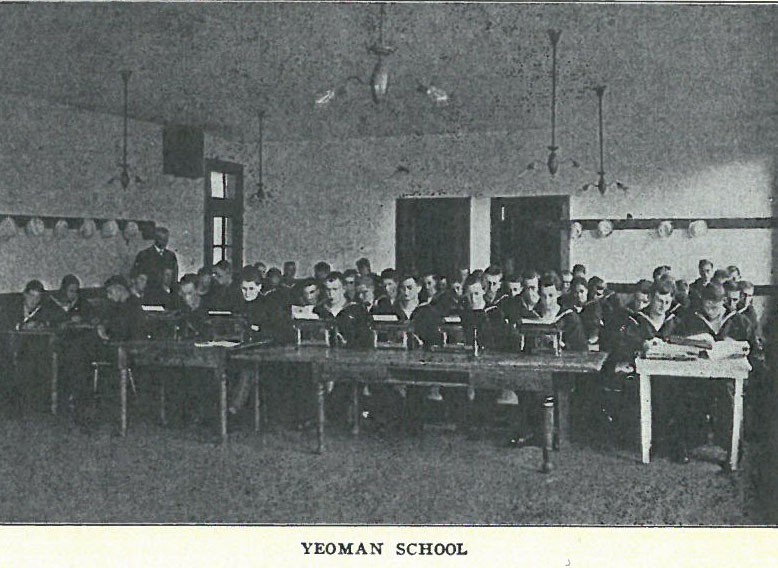
join a class in stenography after hours. The yeoman school is divided as follows:
(a) Preliminary classes, where instruction is imparted in arithmetic, spelling composition and such information regarding the naval service as will enable the student to grasp the work which he will take up later. The preliminary classes vary in length from four to six weeks, at the end of which, examinations are held to determine the student’s aptitude for the other classes.
(b) The supply-officer-department, in which the students are instructed in preparing requisitions, surveys, pubic-bills, official returns, etc; in the methods of bookkeeping, inventories, mess-statements and balance-sheets.
(c) The executive-officer department, where the students learn the duties required in keeping enlisted men’s records and the use of the forms employed in keeping track of the arrival and departure of men, ratings and disratings, appointments, discharges, desertions and deaths.
(d) Pay-officer department, in which a thorough knowledge of arithmetic is required and the student is taught how to make out payrolls, compute the pay of officers and men, credit, interest, clothing accounts, allowances, bounties, extra pay, checkages, allotments, deposits, etc.
(e) The commanding-officer department teaches students the proper care and handling of the typewriter and the forms of official correspondence used in the naval service. They are
28
instructed in the writing of official letters, endorsements, the channels through which they pass, system of filing, proceedings of courts-martial, courts of inquiry, inquests, etc.
Each of these four classes is five weeks in length. Each member of the class must serve, in turn, as messman for the members of the classes for at least a week. The class hours at Newport are from 8:00 to 11:00 a.m., and 1:00 to 3:00 p.m. Those entering the stenography class still have ample time in which to keep with their regular classes. After graduating from the yeoman school and having been advanced in rating to yeoman, 3d class or 2d class (according to their competency), the students are, as a rule, allowed ten days leave of absence, with travel-time; after which they are sent to the ship or station which needs their service.
HOSPITAL CORPS TRAINING SCHOOLS Training schools for the hospital corps are located a the training stations, Newport, R.I., and San Francisco, Calif. Their object is to train new members of the hospital corps by preliminary instruction in their duties in the car of the sick and injured of the Navy. The course consists of elementary instruction in the following subjects: anatomy and physiology; nursing, first aid and emergency surgery, operating-room and surgical technique; hygiene and sanitation, diet, foods, cooking, mess management; pharmacy material medica and toxicology, medicines and medicinal agents of the U.S. Naval Supply Table,
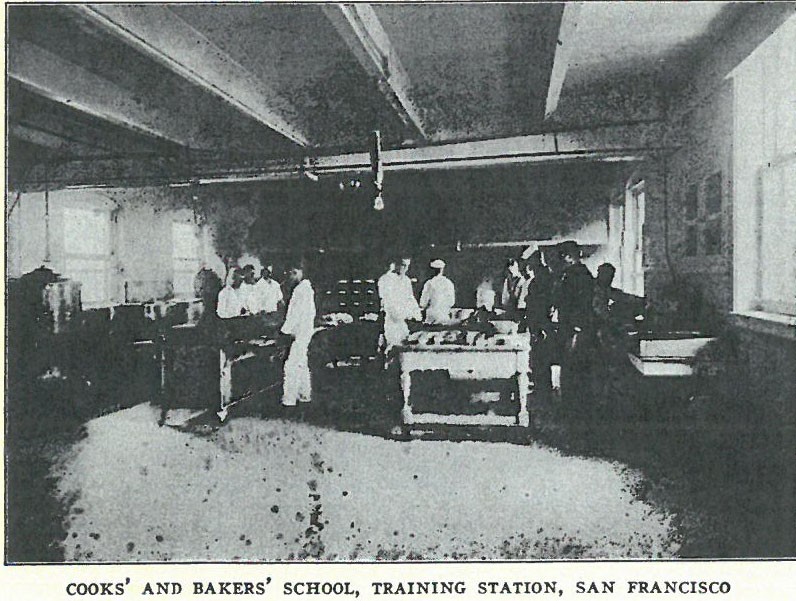
chemistry; hospital duties, ward management and clerical duties.
After completing the course of instruction at the training school, hospital apprentices are assigned either to a Naval hospital for a short period of practical bedside instruction in the care of the sick, or to a cruising ship, as the service requires.
MUSICIAN SCHOOLS Schools are maintained for musicians, both recruits and men already in the Navy, at the training stations at Norfolk, Va., Great Lakes, Ill., and San Francisco, Calif. Applicants must be able to read music and play the easy grades on band instruments, either string or brass, and on the piano. The course is eight months long.
COMMISSARY SCHOOLS Schools for ship’s cooks, bakers and commissary-stewards are located at San Francisco, Calif. and at Newport, R.I. For the present, men are enlisted as landsmen for ship’s cooks or for bakers; and commissary-stewards are advanced from the lower ratings. Applicants must have a knowledge of the trade for which they apply. The course is six months in length in each class.
MACHINIST SCHOOL The machinist-school is located at Charleston, S.C., and is open only to re-enlisted men under 30 years of age in the ratings of water-tender, oiler and fireman, 1st class. Recruits are not admitted to this
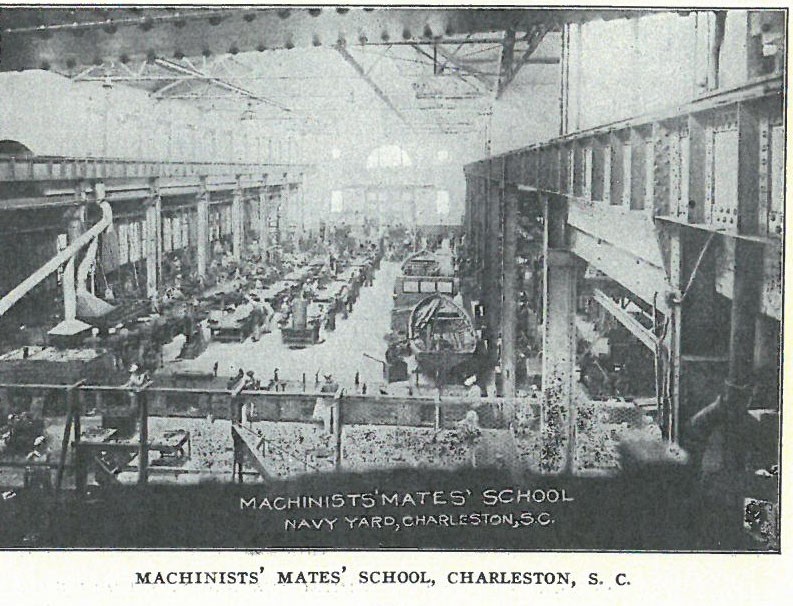
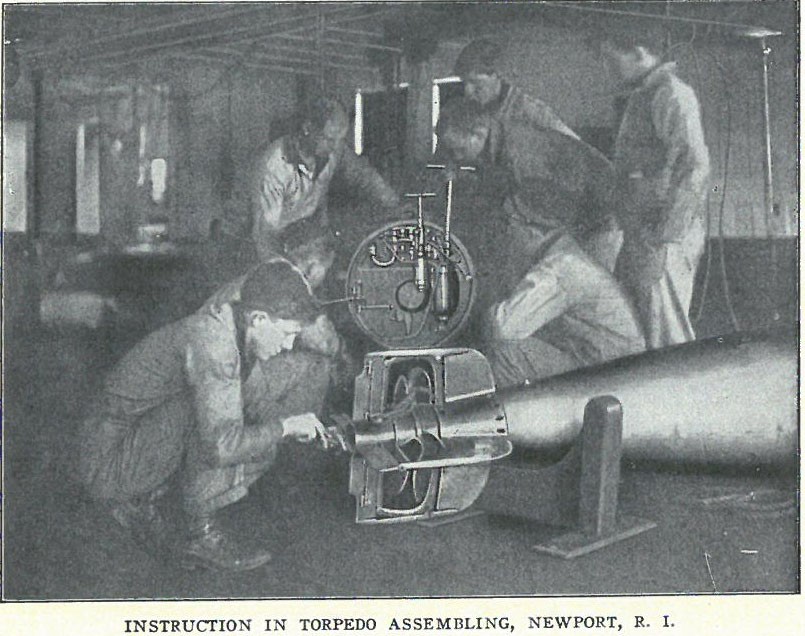
school. The length of the course is sixteen months, and the students are given a thorough course in the knowledge of the machinist trade.
COPPERSMITH SCHOOL The coppersmith-school also is located at Charleston, S.C., and is open only to re-enlisted men with some knowledge of the coppersmith trade. The length of the course is six months.
AERONAUTIC SCHOOL At the aeronautic station, Pensacola, Florida, there is a school for the instruction of men in flying. Classes are formed every three months, composed of sixteen enlisted men of the Navy who are selected for the instruction by the Commander-in-Chief of the U.S. Atlantic Fleet. The course is eighteen months long and is divided into two classes, - mechanics and flying. Upon completion of the course, the men are issued a certificate of qualification which entitles them to additional pay of fifty per cent while detailed to duty involving actual flying; and , in the event of their death from wounds, or disease, the result of an aviation accident while engaged in actual flying or in the handling of aircraft, a gratuity is paid the beneficiary amounting to one year’s pay at the rate received at the time of the accident; and the pensions allowed by the law are doubled.
31
INSTRUCTION IN GASOLINE ENGINES There is a class at Charleston, S.C. in connection with the machinist school, for instruction in gasoline engines. This class is limited to twenty men and the class is formed every three months. Only men in the ratings of fireman, 1st and 2d class, and oilers, are eligible; and preference is given reenlisted men. This school is not open to recruits.
SEAMAN GUNNER SCHOOLS These schools are located at the Navy Yard, Washington, D.C., and at the Naval Torpedo Station, Newport, R.I. The school at Newport is known as the torpedo-class; classes are formed January 1st, May 1st, and September 1st, and continue for eight months.
A special class for machinists’ mates is located at the Torpedo Station for the instruction of reenlisted men in the duties of machinists’ mates, “torpedo.”
There is also located at the Torpedo Station, Newport, a class for instruction in deep-sea diving. The candidates are specially apt pupils of the torpedo-class and are not drawn from men on first enlistment.
The school at Washington is devoted to ordnance and the students are taught the assembling of guns, breech mechanism, and everything to do with the practical part of ordnance, the manufacture of shells, fuses and the working of electrical devices. This school is assembled twice a year and the course of instruction is six months long.
Men to be eligible for either school must have served continuously and be not over 30 years of age. Upon the completion of the course they received a certificate which entitles them to two dollars a month additional pay.
REQUIREMENTS FOR ENLISTMENT
The term of enlistment of all enlisted men of the Navy is 4 years, except minors over 17 and under 18 years of age, who shall be enlisted for the period of minority. Minors under 17 cannot enlist in the Navy except by special permission of the Bureau of Navigation. No enlistments for special service are allowed.
No minor under the age of 18 years will be enlisted without the written consent of the parent who is his legal guardian; or, if both parents are dead, of a legally appointed guardian.
Only those young men who can reasonably be expected to remain in the service throughout their enlistment will be accepted.
32
TABLE OF PHYSICAL PROPORTIONS FOR HEIGHT, WEIGHT, AND CHEST MEASUREMENT OF ADULTS.
(barefoot).
|
Weight (without clothes.) |
Chest, mean circumference. |
| Inches | Pounds | Inches |
| 64 | 128 | 33 |
| 65 | 130 | 33 |
| 66 | 132 | 33 1/2 |
| 67 | 134 | 34 |
| 68 | 141 | 34 1/2 |
| 69 | 148 | 34 3/4 |
| 70 | 155 | 35 1/4 |
| 71 | 162 | 36 |
| 72 | 169 | 36 1/4 |
| 73 | 176 | 36 3/4 |
Every person before being enlisted must pass the physical examination prescribed in the medical instructions, and no person shall be enlisted for the naval service unless pronounced fit by the commanding and medical officers.
The minimum height for acceptance of a man 21 years old or over, is 64 inches barefooted.
The minimum weight for acceptance of a man 21 years old is 128 pounds. A variation of 10 pounds, not to fall below 128 pounds in weight, or 2 inches in chest measurement below the standard given in the table for adults, is admissible when the applicant for enlistment is active, has firm muscles, and is evidently vigorous and healthy, except for enlistment in the rate of fireman 3d class, for which rate full standard measurements will be required.
Chest expansion of less than 2 inches in a minor or of less than 2 ½ inches in an adult is a sufficient cause for rejection of an applicant.
Applicants between the ages of 17 and 18 must obtain the written consent of their parents or guardians, on forms provided for that purpose, on application to any recruiting station or navy yard, before proceeding to the recruiting station. Those between the ages of 18 and 21 should similarly obtain an age certificate and have it filled out and signed before leaving home.
EVIDENCE OF AGE AND CITIZENSHIP The law requires that every applicant for enlistment as apprentice seaman must, if a minor, present a certificate of birth, or verified written statement by his parents or either of them, or in case of their death, a verified written statement by his legal guardian, showing the applicant to be of age required by the Navy regulations, before he can be enlisted. He must also produce satisfactory evidence of his United States citizen-
33
ship, native or naturalized. Blanks are provided for this purpose. No minor under the age of 17 years, no insane or intoxicated person, and no deserter from the naval or military service of the United States, shall be enlisted in the naval service.
No man convicted of any serious offense will be enlisted without special permission of the Bureau of Navigation.
Fraudulent enlistment, and the receipt of any pay or allowances thereunder, is an offense against naval discipline, and is punishable by general court-martial. (Act approved Mar 3, 1893).
First enlistment in the Navy shall be made only in the ratings of the following table and between the ages therein specified for the different ratings:
Rating. |
Years or age. | Rating. | Years of age. |
| Seamen | 21 to 30 | Shipfitters, 2d class | 21 to 30 |
| Seamen 2d class | 18 t0 30 | Coppersmiths | 21 to 30 |
| Apprentice Seamen | 17 to 25 | Firemen, 1st class | 21 to 30 |
Landsmen (not for seamen branch) |
18 to 25 | Firemen, 2d class | 21 to 30 |
| Shipwrights | 21 to 30 | Hosp. apprentices, 2d class | 21 to 30 |
| Blacksmiths | 21 to 30 | Firemen, 3rd class | 18 to 25 |
| Plumbers and fitters | 21 to 30 | Bakers, 2d class | 21 to 30 |
| Sailmakers' mates | 21 to 30 | Mess attendants, 3d class | 18 to 30 |
| Machinists' mates, 1st class | 21 to 30 | Musicians, 1st class | 21 to 30 |
| Machinists' mates, 2d class | 21 to 30 | Musicians, 2d class | 21 to 30 |
| Boilermakers | 21 to 30 | Painters, 3d class | 21 to 30 |
All applicants for enlistment in the Navy must personally appear at a Navy recruiting station or navy yard, and there be examined as to their qualifications for enlistment. Applicants residing at a distance from such recruiting station or navy yard should, in all cases, carefully consider whether they can meet the requirements for enlistment as given in this booklet. If necessary, they should consult a local physician and ascertain the probabilities of their being able to conform to these requirements. If reasonably sure of passing the physical examination, they should then write to the recruiting station or navy yard at which they intend to apply for enlistment, requesting to be informed as to whether or not enlistments are being made in the ratings for which they are eligible, or, if enlistments are not then being made in those ratings, to be notified as soon as they are being made.
This course is suggested as no allowance is made for travelling expenses of applicants, and they should be as certain as possible of their ability to pass the examination before incurring any expense. Transportation is furnished only to accepted applicants from the recruiting station to the point of assignment.
Frequently enlistments are suspended in some of the ratings mentioned in the foregoing table, and an applicant should not take it for granted that enlistments are being made in a given trade.
34
The tables are given to show what is regarded as a fair standard of physical proportions and not as an absolute guide to be followed in deciding upon the acceptance of recruits.
For a minor enlisting as apprentice seaman:
Minimum height barefooted. |
Minimum weight without clothes. |
|
| Inches. | Pounds. | |
| At 17 years of age | 62 | 110 |
| At 18 years of age | 64 | 115 |
| At 19 years of age | 64 | 120 |
| At 20 years of age | 64 | 125 |
No underweight or under height is allowed in minors.
Marked disproportion of weight over height is not a cause for rejection unless the applicant is positively obese.
Any one of the following conditions will be sufficient to cause the rejection of the applicant:
1. Feeble constitution, general poor physique, or impaired general health.
2. Any disease or deformity, either congenital or acquired, that would impair efficiency, such as: Weak or deranged intellect, cutaneous disease not of a milt type, parasites of the skin or its appendages, deformity of the skull, abnormal curvature of the spine, torticollis, inequality of upper or lower extremities, inefficiency of joints or limbs, deformity of joints or bones, either congenital or the result of disease or injury, flat feet, evidence of epilepsy or other convulsions, defective vision (minimum 15-20 S. in either eye), disease of the eye, color-blindness, impaired hearing or disease of the ear, chronic nasal catarrh, ozaena, polypi, great enlargement of tonsils, impediment of speech, disease of heart of lungs or predisposition to such disease, enlarged abdominal organs or evidence of cirrhosis, tumors, hernia, undescended testicle, large varicocele, sarocele, hydrocele, stricture, fistula, hemorrhoids, large varicose veins, disease of the geniro-urinary organs, chronic ulcers, ingrowing nails, bad corns, large bunions, deformity of toes, loss of many teeth or teeth generally unsound (teeth properly filled not to be considered unsound). Every recruit must have a least 20 sound teeth, and of these not less than 4 opposed incisors and 4 opposed molars.
3. Any acute disease.
Each recruit shall be required to take the oath of allegiance. He will also be required to declare on oath, in the presence of the recruiting officer, that he makes a true statement as to the date and place his birth, and his previous service, if any, in the Navy, Marine Corps, Army, or Coast Guard Service; and also
35
that he is not subject to fits, has no disease concealed or likely to be inherited, and has no stricture or internal piles.
Applicants for enlistment must be American citizens, native or fully naturalized, and must be able read and write English. “First papers” are not sufficient.
Twenty cents a month is deducted from the pay of each man to be applied to the fund for naval hospitals.
No man shall be enlisted as a seaman, or seaman, second class, without permission of the Bureau of Navigation, unless he shall have been discharged from the Navy with recommendation for re-enlistment. Seamen, second class, receive $20.90 a month, and are advanced when qualified, and when vacancies occur, to seamen, at $26.40 per month. Seamen are eligible, if qualified, to fill vacancies as petty officers.
ENLISTMENT IN TRADES Men possessing a mechanical trade not enumerated in the table may be enlisted for duty in that trade, even if over 25, provided they are under 30 years of age.
Firemen, third class. –Pay $24.20 per month. Applicants for this rating must have had actual experience in the fireroom in the Navy or on board a merchant vessel. The recruiting officer may use his discretion in enlisting a man who is especially desirable, notwithstanding the fact that he has had no previous experience on board ship in the duties of this rating.
Firemen, second class. –Pay $33 per month. Must have had had experience as firemen, preferably on board a steamer; must understand the management of the fires, and must have some knowledge of the engines, different pumps, boilers and attachments thereto, and their uses.
Firemen, first class. –Pay $38.50 per month. Must have had two years’ experience as firemen on board a steamer; must be familiar with marine engines and boilers and their attachments; must thoroughly understand the management of the fires, the use and regulation of the different valves on the boilers, and the different pumps; should know how to put on a soft patch, and to be able to wrap pipes to stop leaks; must be able to pack the stuffing boxes around the engines, and to grind in valves, etc.; also to oil the different parts of the engine.
Shipwrights. –Pay, $27.50 per month. Applicants for enlistment as shipwrights must be fairly familiar with the ordinary woodwork repairs generally required on board ship.
Carpenters’ mates, third class. –Pay $33 per month. Applicants for enlistment in this rating will be enlisted as shipwrights (for carpenters’ mates, third class), and upon qualifying as a result of examination on board a naval vessel will be promoted to carpenters’ mates, third class.
36
Carpenters’ mates, second class. –Pay $38.50 per month. Applicants for enlistment in this rating will be enlisted as shipwrights (for carpenters’ mates, second class), and upon qualifying as a result of examination on board a naval vessel will be promoted to carpenters’ mates, second class.
Carpenters’ mates, first class. –Pay $55 per month. This rating is obtained by promotion from carpenters’ mates, first class.
Machinists’ mates, second class. –Pay $44 per month. Applicants for enlistment in this rating must be machinists by trade; must be familiar with the names and uses of the various parts of marine or stationary engines and boilers; must be able to perform work with the various tools in a machine shop, including bench work; must be able to write legibly and understand arithmetic; must be physically sound, and at the date of first enlistment must be not less than 21 nor more than 30 years of age.
Machinists’ mates, second class, are not required to have had experience at sea with marine engines; they may be assigned to duty as water tenders and oilers.
The examination of candidates for enlistment as machinists’ mates regarding their knowledge of engines and boilers will be made, if practicable, in the engine rooms of ships, and regarding their knowledge of machine work, in the workshops of navy yard.
Machinists’ mates, first class. –Pay $60.50 per month. Applicants for enlistment as machinists’ mates, first class, must have had experience at sea for one year with marine engines, in addition to the qualifications for machinists’ mates, second class. Machinists’ mates, second class, are promoted to machinists’ mates, first class, as soon as they prove their qualification on board a cruising vessel and vacancies exist.
Machinists’ mates, first class, will if qualified, be given charge of an engine-room watch when there is not a sufficient number of chief machinists’ mates on board to perform this duty.
Chief machinists’ mates. –Pay, $77 per month. Chief machinists’ mates will have charge of engine-room watches. No person will be enlisted as chief machinists’ mate unless he holds a permanent appointment as such. The rating of chief machinists’ mate is attained by promotion from the lower ratings in this branch.
The Electrical branch. –The requirements for enlistment in the electrical branch are described in the chapter, “Navy Trade Schools.” The pay of electrician, third class, is $33 per month; electrician, second class, $44 per month; electrician, first class, $55 per month; chief electrician with acting appointment, $66; permanent appointment, $77 per month. All recruits in the
37
electrical branch enlist as landsman for electrician (general or radio) at $17.60 per month.
The Yeoman branch. –All recruits in the yeoman branch enlist as landsman-for-yeoman at $17.60 per month. After qualifying at the Yeoman School, men are advanced to yeoman, third class, pay of which is $33 per month; pay of yeoman, second class, is $38.50; yeoman, first class, $44; a chief yeoman with acting appointment, $77. A knowledge of short-hand is not a requirement for obtaining permanent appointment.
Coppersmiths. –Pay, $60.50 per month. Applicants for enlistment in this rating must be competent coppersmiths by trade and preferably with previous sea experience.
B oilermakers. –Pay, $71.50 per month. Applicants for enlistment in this rating must be competent boilermakers by trade and preferably with previous sea experience. Boilermakers are enlisted only to fill vacancies, and applicants should first ascertain if men are needed in this rating before applying.
Blacksmiths. –Pay, $55 per month. Applicants for enlistment in this rating must be competent blacksmiths by trade and preferably with previous sea experience. Blacksmiths are enlisted only by permission of the Bureau of Navigation.
S hipfitters, second class. –Pay, $60.50 per month This rating is obtained by promotion from shipfitter, second class, after proving capabilities on board ship.
Plumbers and fitters. –Pay, $49.50 per month. Enlisted only by special permission. Must be competent plumbers and fitters by trade, preferably with previous sea experience.
S ailmakers’ mates. –Pay, $44 per month. Enlistments in this rating are only made as a result of examination at a navy yard, proving competency.
Painters, third class. –Pay, $33 per month. Must be competent painters by trade, preferably with previous sea experience. Painters are enlisted only to fill vacancies.
Painters, second class. –Pay, $38.50 per month. This rating is obtained by promotion from painters, third class.
38
Painters, first class. –Pay, $44 per month. This rating is obtained by promotion from painters, second class.
Ship’s cooks. –Recruits must be competent plain cooks and may be enlisted as landsmen (for ship’s cooks), pay $17.60 per month while under instruction. They will be sent to the ship’s cooks’ class at the Commissary School, where they will be required to qualify before receiving the rating of ship’s cook. Fourth class. No promise can be given at the time of enlistment that a recruit will be advanced to a higher rating than ship’s cook, fourth class, and such men must qualify at the Commissary School before being advanced to this rating.
Ship’s cook, fourth class. –Pay, $27.50 per month.
Ship’s cook, third class. –Pay, $33 per month.
Ship’s cook, second class. –Pay, $60.50 per month (Attained by advancement from rating of ship’s cook, second class).
Commissary stewards. –Pay, $66 per month. Must be qualified by examination and experience on board ship, and must have a thorough knowledge of keeping accounts, the purchase of supplies, and the supervision and control of a considerable number of cooks and messmen, and be competent to superintend the messing arrangement of messes for 150 to 300 men. First enlistments in this rating have been discontinued. Applicants for commissary steward are limited to qualified ship’s cooks, first class, and bakers, first class.
Chief commissary stewards. –Pay, $77 per month. Men in this rating are promoted from commissary stewards after qualifying by examination and experience on board ship. Qualifications are the same as for commissary stewards, excepting that they must be competent to provide for and superintend the messing arrangement of messes of from 300 to 850 men.
Bakers, second class. –Pay, $38.50 per month. Must be bakers by trade and must present recommendations showing qualifications and reliability. Bakers are enlisted as landsmen (for baker), pay $17.60 a month, and will be sent to the commissary school, where they will be required to qualify before given the rating of baker.
Bakers, first class. –Pay, $49.50 per month. This rating is obtained by promotion from bakers, second class, after proving capabilities on board ship.
Cabin stewards. –Pay, $55 per month. Applicants for enlistment in this rating must present recommendations showing previous experience and that they are competent to purchase the necessary supplies, keep the necessary accounts, and have sufficient
39
force to superintend in all respects the cooks and mess attendants under their charge. Applicants will be enlisted as mess attendants, third class, and then rated cabin stewards.
Wardroom stewards. –Pay, $55 per month. Applicants for enlistment in this rating must present recommendations showing previous experience and that they are competent to purchase the necessary supplies, keep the necessary accounts, and have sufficient force to superintend in all respects the cooks and mess attendants under their charge, and to cater to from 12 to 30 persons. Applicants will be enlisted as mess attendants, third class, and then rated wardroom stewards.
Steerage stewards. –Pay, $38.50 per month. Applicants for enlistment in this rating must present recommendations showing previous experience and that they are competent to purchase the necessary supplies, keep the necessary accounts, and have sufficient force to superintend in all respects the cooks and mess attendants under their charge, and to cater from 8 to 18 persons. Applicants will be enlisted as mess attendants, third class, and then rated steerage stewards.
Warrants officers’ stewards. –Pay, $38.50 per month. Applicants for enlistment in this rating must present recommendations showing previous experience and that they are competent to purchase the necessary supplies, keep the necessary accounts, and have sufficient force to superintend in all respects the cooks and mess attendants under their charge, and to cater from 6 6o 12 persons. Applicants will be enlisted as mess attendants, third class, and then rated warrant officers’ stewards.
Cabin cooks. –Pay, $49.50 per month. Must be competent and first-class cooks and present recommendations showing reliability and ability. Applicants will be enlisted as mess attendants, third class, and then rated cabin cooks.
Wardroom cooks. –Pay, $49.50 per month. Must be competent and first-class cooks and present recommendations showing reliability and ability. Must be competent to cook for from 12 to 30 persons. Applicants will be enlisted as mess attendants, third class, and then rated wardroom cooks.
Steerage cooks. –Pay, $33 per month. Must be competent and first-class cooks and present recommendations showing reliability and ability. Must be competent to cook for from 6 to 12 persons. Applicants will be enlisted as mess attendants, third class, and then rated warrant officers’ cooks.
Warrant officers' cooks. --Pay, $33 per month. Must be firstclass plain cooks and present recommendations showing reliability and ability. Must be competent to cook for from 6 to 12 persons. Applicants will be enlisted as mess attendants, third class, and then rated warrant officers' cooks.
When mess attendants who have been advanced to the rating
40
of cook or steward have served one year in said ratings and are recommended by their commanding officers, they shall be given certificates of qualification from the Bureau of Navigation, and so long as they hold such certificates shall be re-enlisted in the rating designated on the same. Certificates of qualification may be revoked for incompetency, undesirability, or bad conduct.
All stewards and cooks in the messman branch, who are citizens of the United States, and who hold certificates of qualification as stewards or cooks shall receive, $5.50 per month additional to the pay of their rating while holding such certificate, such additional pay to be of a permanent character as regular pay.
Mess attendants, third class. –Pay, $17.60 per month (if American citizens, pay is $22 per month). Only desirable applicants, who have had previous experience in hotels, clubs, restaurants, or private families will be enlisted in this rating, and then only upon presenting recommendations from previous employers.
Mess attendants, second class. –Pay, $$22 per month. (if American citizens, pay is $27.50 per month). Vacancies in this rating are filled by promotion of competent mess attendants, third class, who have served satisfactorily in that rating.
Mess attendants, third class, will not be rated mess attendants, second class, until they have served satisfactorily for one year as mess attendants, and mess attendants, second class, will not be rated mess attendants, first class, until they have served satisfactorily for one year as mess attendants. Well qualified and deserving mess attendants, second or third class, may however, be advanced in rating earlier by special authority from the Bureau of Navigation. To be eligible for promotion, their standing in proficiency, sobriety, and obedience must not be less than 3.2.
Musicians. –An applicant for enlistment as musician, first or second class, must be able to read band music and must prove his ability to play some band instrument. Men for this rating are enlisted as musician, second class, $33 per month; or if specially well qualified, as musician, first class, $35.20 per month. Enlistments made only to fill vacancies.
First musician. –Pay, $39.60 per month. This rating is filled by promotion of musicians, first class.
Bandmaster. –Pay, $57.20 per month. This rating is filled by the promotion of first musicians who are specially well qualified and recommended for the position. Promotions are made only to fill vacancies.
41
The Hospital Corps Owing to the character of the work required of the Hospital Corps, an applicant is enlisted in the Corps only after his qualifications are determined by a preliminary mental and professional examination and then only in the ratings of hospital apprentice, 2d class, and hospital apprentice 1st class. First enlistments in the Hospital Corps are made in the rating of hospital apprentice, 2d class, unless special authority is issued (for hospital apprentice 1st class) by the Navy Department; and all enlistments are for a term of 4 years for service in any part of the world, either ashore or afloat, as service requirements demand. A knowledge of an experience in nursing is of advantage to the applicant.
No enlistments are made as pharmacist, druggist, drug-clerk, or embalmer, as such; but persons having such an education or experience are given favorable consideration when applying for enlistment.
No person will be enlisted or retained in the Hospital Corps who is addicted to the use of intoxicating liquors or drugs, or who at any time shows evidence of intemperance or the morbid use of drugs.
No person temperamentally unfitted for this class of work will be accepted.
The work of the Hospital Corps consists in attendance upon the sick of the Navy and Marine Corps, both officers and men, in naval hospitals, naval shore stations, on board ships, and upon expedition of the Marine Corps. The work is not attended by particularly arduous duties, and fits the members of the corps for future work in connection with their profession, within and without the Naval service.
Well qualified men; or earnest men with ambition, after diligent study, are able to advance themselves to the higher ratings provided they meet the requirements at the time, of eligibility and examination. Only Chief Pharmacists’ Mates having the required qualifications are eligible for advancement to the warrant grade of Pharmacist.
The pay of a Hospital Apprentice 2nd class is $20.90 per month; Hospital Apprentice 1st class $26.40 per month; Pharmacist’s Mate 3rd class $33.00 per month; Pharmacist’s Mate 2nd class $38.50 per month; Pharmacist’s Mate, acting appointment $66.00 per month; Chief Pharmacist’s Mate, acting appointment $77.00 per month.
To obtain the highest pay a man must be thoroughly familiar with the duties of his rating, be of good conduct, temperate, and temperamentally fitted for the work of the Medical Department.
The Hospital Corps consists of the following:
Hospital Apprentice 2nd Class (Rating as seaman
42
second class) –Age for enlistment 18 to 25 years. The applicant is examined in arithmetic, spelling, writing, geography and history of the United States. Upon enlistment Hospital Apprentices 2nd class are detailed to a Hospital Corps Training School for six months’ course of instruction is completed. Upon completion of this course, and graduation from one of these schools, men will be advanced to the rating of Hospital Apprentice 1st class. Subsequent to completing the course at the Training School they must serve at least six months[sic] in the rating of Hospital Apprentice 1st class before they are eligible for further advancement.
Hospital Apprentice vst [sic] class (Rating as seaman) –Age for enlistment 21 to 28 years. Permission must be obtained from the Bureau of Medicine and Surgery, Navy Department, to be examined for enlistment in this rating. The applicant is examined in: General education; arithmetic, orthography, writing (legible and grammatical), geography and history of the United States, elementary anatomy, physiology, minor surgery and first aid, and such general subjects as are taught in the Hospital Corps Training School. Upon first enlistment Hospital Apprentices 2st class will be detailed to one of the Hospital Corps Training Schools for a six months’ course of instruction. Upon completion of the course, and graduation from one of these schools, they receive no advancement, but must serve at least 12 months in the rating of Hospital Apprentice 1st class before they are eligible for further advancement.
Pharmacist’s Mate 3rd class (Rating as petty officer third class) –No Hospital Apprentice 1st class shall be advanced to
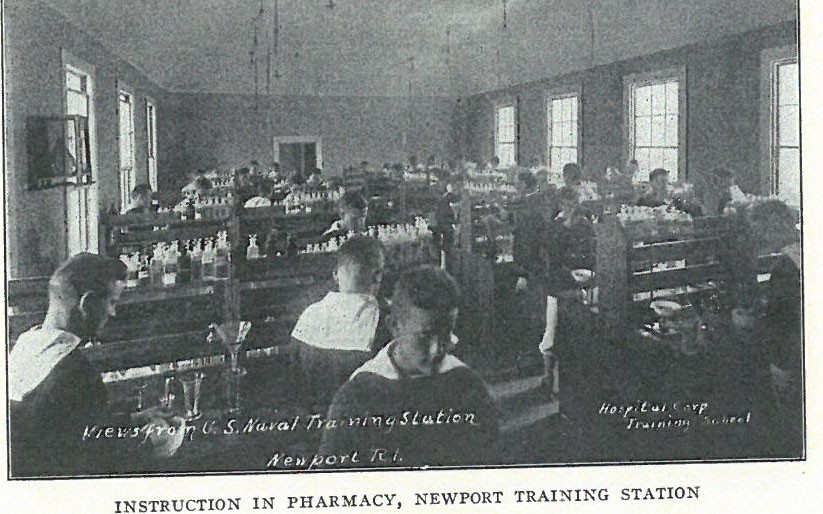
Pharmacist’s Mate 3rd class until he has served at least 12 months in the Hospital Corps, and no man who has not so served is eligible for examination for this advancement. The following examination is required: Aptitude, general education, anatomy and physiology, minor surgery and first aid, nursing and materia medica, elementary hygiene and sanitation.
Pharmacist’s Mate 2nd class (Rating as petty officer second class) –Men must have served in the rating of Pharmacist’s Mate 3rd class for at least 12 months before they are eligible for advancement to Pharmacist’s Mate 2nd class. The examination for this rating will be held in aptitude, general education, anatomy and physiology, minor surgery and first aid, nursing and material medica elementary hygiene and sanitation, diets and messing for the sick, and clerical procedures and forms.
Pharmacist’s Mate 1st class (Rating as petty officer first class) –Men must have served in the rating of Pharmacist’s Mate 2nd class for at least 12 months before they are eligible for advancement to this rating. The examination will be as follows: Aptitude, general education, anatomy and physiology, minor surgery and first aid, nursing and material medica, elementary hygiene and sanitation diets and messing for the sick, clerical procedures and forms, pharmacy and chemistry, sick bay and ward duties, practical work in all subjects.
Chief Pharmacist’s Mate, acting and permanent (Rating of chief petty officer) –Men must serve in the rating of Pharmacist’s Mate 1st class for at least 18 months before they are eligible for examination for advancement to chief petty officer, acting appointment. Advancement to the rating of Chief Pharmacist’s Mate will depend upon the demands of the service for chief petty officers. A Pharmacist’s Mate 1st class will not be advanced to the rating of Chief Pharmacist’s Mate during his first enlistment. The examination will be as follows: Aptitude, general education, anatomy and physiology, minor surgery and first aid, nursing and materia medica, elementary hygiene and sanitation, diets and messing for the sick, clerical procedures and forms, pharmacy and chemistry, sick bay and ward duties, practical work in all subjects.
The general average of 3.2 for Pharmacist’s Mate 1st class; 3.2 for Chief Pharmacist’s Mate, acting appointment and 3.6 for Chief Pharmacist’s Mate, permanent appointment, will be required, the character of the examination being somewhat more searching according to the rating.
The duties of men in the rating inferior to Pharmacist’s Mate 1st class are those of nurses in charge of wards, assistants in dispensaries and operating rooms, nurses on serious cases, etc. These men receive practical instruction in a hospital early in their enlistment before any responsibility is placed upon them.
44
The duties of the Chief Pharmacist’s Mate and Pharmacist’s Mate 1st class consist in compounding medicines, keeping records, making returns and such other clerical work as may be required, the maintenance of discipline and cleanliness in sick bays and wards, etc. Their duties are responsible, requiring ability, confidence and attention to duty.
A Pharmacist is a warrant officer. Chief Pharmacist’s Mates only are eligible for this grade, all vacancies being filled by promotion of suitably qualified applicants from this rating. Promotion of suitably qualified applicants from this rating. Promotion is dependent upon length of service, efficiency record, and fitness as determined by physical and professional examination.
Training and advancement in the Hospital Corps is similar to that experienced in other branches.
CONCERNING REENLISTMENTS Every person who, upon the expiration of a four-year term of enlistment, holds an honorable discharge, an ordinary discharge bearing a recommendation for reenlistment, or a continuous-service certificate upon which there is endorsed “honorable” or “ordinary” discharge, shall, on presenting himself for reenlistment at any naval rendezvous or receiving ship. Or on board any cruising ship not in the presence of a rendezvous or receiving ship, within four months from date of his discharge as shown thereon, be immediately reenlisted, regardless of complement, provided he is physically qualified and answers to the descriptive list of his discharge.
Should any person eligible for continuous service be found physically disqualified for reenlistment, a copy of the record of his medical examination shall be forwarded immediately to the Navy Department, with the recommendations of the commanding and medical officers. Pending a reply from the department, the discharge shall be held by the recruiting officer, and the owner may, if he so elect, remain during such time on board ship.
Any person who, upon the expiration of a four-year enlistment receives an honorable discharge, or a recommendation for reenlistment indorsed upon an ordinary discharge, shall, upon reenlistment for four years within four months from the date of his discharge, receive in exchange for said discharge a continuous-service certificate.
A chief petty officer honorably discharged with a permanent appointment, who presents himself for reenlistment within four months from the date of his discharge, shall, if physically qualified, be enlisted in the rating of the permanent appointment under which he was serving at the time of his discharge. Chief petty officers not holding permanent appointments will be reenlisted as petty officers, first class, and their appointments as chief petty officers renewed. Petty officers, other than chiefs,
45
who have been discharged in their ratings as petty officers, and whose records and conduct are satisfactory, shall be enlisted in the rating held on discharge, provided such reenlistment is within four months of date of discharge.
Men holding certificates as seamen gunners are entitled to the pay prescribed for said rating, and are entitled to reenlist as such.
Other persons can be reenlisted only in some rating authorized for first enlistment.
Ship’s cooks, third and fourth classes; bakers, second class, and mess attendants may, within four months from the date of honorable discharge, reenlist in the rating and class in which discharged.
Officers’ cooks and stewards holding certificates of qualification reenlisting within four months from the date of honorable discharge, reenlist in the rating and class in which discharged.
Officers’ cooks and stewards holding certificates of qualification reenlisting within four months from date of honorable discharge are to be enlisted in the rating designated on the certificate.
No one who has already been in the naval or military service or the Coast Guard Service of the United States shall be enlisted without showing his discharge therefrom. Should it be claimed that the discharge has been lost, the circumstances shall be reported to the Navy Department.
Beneficiaries who have been admitted to the Naval Home and pensioners shall not be enlisted.
Any person with a continuous-service certificate which is indorsed “discharged with a bad-conduct discharge,” dishonorably discharged,” or “not recommended for reenlistment,” shall not be reenlisted.
A man will not be advanced to chief petty officer during first enlistment, but towards the completion of his first enlistment, may be recommended for chief petty officer, with a view to his advancement upon reenlistment if a vacancy exists.
FURLOUGHS Enlisted men of the Navy may be furloughed by the Secretary of the Navy, without pay, for the unexpired portion of their enlistment. Men so furloughed shall be subject to call in time of war or national emergency to complete the unexpired portion of their enlistment. To be entitled to this privilege, men must not be undergoing punishment, under charges or in debt to the government. They must reimburse the government for expenses incurred in their behalf, and for which adequate return by service has not been made as follows:
During first enlistment:
(a) Apprentice seamen or other enlisted men undergoing a probationary period of training at training stations and before being sent to a ship or other station: By reimbursing[sic] the Gov-
46
ernment for the cost of that portion of outfit drawn and for the cost transportation at the rate of three cents per mile from the place of enlistment to the training station.
(b) Men other than those who enlist as apprentice seamen: During the first six months of enlistment, by reimbursing the Government for the cost of outfit drawn and for the coast of transportation at the rate of three cents per mile from the place of enlistment to the place of first duty.
(c) After the first year of enlistment, by reimbursing the Government for the coast of outfit furnished.
Men serving in second or subsequent enlistments, or extension of enlistment, who receive an honorable discharge gratuity upon extending enlistment:
(a) During first year of enlistment, or extension of enlistment, by reimbursing the Government for the total amount of the gratuity and fir the cost of transportation from place of enlistment to place of first duty thereafter, at the rate of three cents per mile.
(b) During second year enlistment, or extension of enlistment, by reimbursing the Government an amount equal to three-fourths the gratuity.
(c) During third year of enlistment, or extension of enlistment, by reimbursing the Government an amount equal to one-half of the gratuity.
(d) During the first nine months of the fourth year of enlistment, or extension of enlistment, by reimbursing the Government an amount equal to one fourth the gratuity.
All applications made with the manifest purpose of avoiding duty on particular ships or stations will not be granted.
A furlough is a privilege and not a right; it will be granted only when the efficiency of the service will not be manifestly impaired, and must receive the specific approval of the man’s commanding officer.
Men who have had the advantages of, and have completed
47
the course of training at a trade school are not entitled to furlough during current enlistment.
HOW AND WHERE TO ENLIST Navy recruiting stations are located in all the larger cities and many of the smaller ones. In addition, Navy recruiting parties make occasional visits to outlying places through-out the country. Information regarding enlistment in the Navy, and the address of the nearest recruiting office will be promptly furnished upon request received at any of the following addresses:
Bureau of Navigation, Navy Department, Washington, D.C.
Navy Publicity Bureau, 318 West 39th St., New York, N.Y.
Applicants for enlistment are examined and enlisted at:
U.S. Naval Training Station, Norfolk, Va.
U.S. Naval Training Station, Newport, R.I.
U.S. Naval Training Station, Great Lakes, Ill.
U.S. Naval Training Station, San Francisco, Cal.
U.S. Navy Yard, Portsmouth, N.H.
U.S. Navy Yard, Washington, D.C.
On board The Receiving Ships at:
Navy Yard, Boston, Mass. Navy Yard, Bremerton, Wash.
Navy Yard, New York, N.Y. Navy Yard, Mare Island, Cal.
Navy Yard, Philadelphia, Pa. Naval Academy, Annapolis, Md.
Navy Yard, Norfolk, Va. Naval Station, Pensacola, Fla.
Navy Yard, Charleston, S.C.
Or the Naval Hospital at:
Portsmouth, N.H. Annapolis, Md.
Chelsea, Mass. Norfolk, Va.
Newport, R.I. Port Royal, S.C.
Brooklyn, N.Y. Las Animas, Colo.
Philadelphia, Pa. Mare Island, Cal.
Washington, D.C. Puget Sound, Wash.
Enlistments are also made on board all U.S. Naval vessels in commission to which Navy medical officers are attached.
A man may enlist at any of the following
U.S. NAVY RECRUITING STATIONS:
PORTLAND, MAINE, 495 Congress St. |
RALEIGH, N.C. Martin & Wilmington Sts. |
| BURLINGTON, VT., Post Office Bldg. | MONTGOMERY, ALA. Ex. Nat. Bank Bldg. |
| BOSTON, MASS, 146 Tremont St. | CHARLESTON, S.C., 209 Meeting St. |
| NEW HAVEN, CONN., 962 Chapel St. | PARKERSBURG, W. VA., 424 Market St. |
| ALBANY, N.Y., 463 Broadway. | NEW ORLEANS, LA., 730 Common St. |
| NEW YORK, N.Y.,34 East 23d St. | JACKSON, MISS., 223 West Captiol St. |
| NEWARK, N.J., 86 Park Place. | OKLAHOMA CITY, OKLA., Grand Ave. and Broadway |
| PHILADELPHIA, PA., 1310 Arch St. | OMAHA, NEB., Post Office Bldg. |
| SCRANTON, PA., Coal Exchange Bldg. | KANSAS CITY, MO., Gumbel Bldg., 8th & Walnut Sts. |
| PITTSBURGH, PA,M Anchor Bank Bldg. | DALLAS, TEX., 1616 1/2 Main St. |
| BALTIMORE, MD., N.E. Cor Calvert and Lexington Sts. | HOUSTON, TEX.,Binz Bldg., Texas Ave., and Main St. |
| RICHMOND, VA., Allison Bldg. | SAN FRANCISCO, CAL., 417 Market St. |
| BUFFALO, N.Y., Post Office Bldg. | LOS ANGELES, CAL., Union Oil Bldg., 7th and Spring Sts. |
| CINCINNATI, O., Post Office Bldg. | SAN DIEGO, CAL., Post Bldg. |
| INDIANAPOLIS, IND., Post Office Bldg. | EL PASO, TEX., 204 1/2 El Paso St. |
| CLEVELAND, O., Post Office Bldg. | DENVER, COLO., Quincy Bldg., 1010 17th St. |
| DETROIT, MICH., Hall Bldg., 161 Griswold | SALT LAKE CITY, UTAH, Keith Emporium Bldg |
| CHICAGO, ILL., 130 North 5th Ave. | PORTLAND, ORE., Dekum Bldg., 3rd and Washington Sts. |
| PEORIA, ILL., Cor Adams & Liberty Sts. | SEATTLE, WASH., Amer. Bank Bldg. |
| MILWAUKEE, WIS., 222 Grand Ave. | |
| MINNEAPOLIS, MINN., Fed. Office Bldg. | |
| DES MOINES, IA., Old Post Office Bldg. | |
| ST. LOUIS, MO., 7th & Chestnut St. | |
| NASHVILLE, TENN., Custom House Bldg. | |
| LITTLE ROCK, ARK., 113 W. Second St. | |
| ATLANTA, GA., Post Office Bldg. |
48
INDEX
| Advantages of Navy | 4 | Machinist's mates | 37 |
| Aeronautic school | 31 | Machinists' school | 39 |
| Age requirements | 33 | Medals of honor, life-saving, etc. | 18 |
| Allowances, extra | 13 | Medical attention | 4 |
| Applications for enlistment, how made | 34 | Mess attendants | 40 |
| Artificer school | 26 | Money, sending home of | 17 |
| Athletics | 24 | Moral and religious influences | 24 |
| Bakers | 30 | Naval Academy, appointments to | 15 |
| Birth certificates | 33 | Naval Reserve | 19 |
| Blacksmiths | 27 | Navy as a career | 3 |
| Boilermakers | 38 | ||
| Officers men advanced to | 15,16 | ||
| Carpenter's mates | 36 | ||
| Citizenship | 33,35 | Painters | 27,38 |
| Clerks, (yeomen) | 27, 38 | Pay , rates of | 8, 10, 11 |
| Clothing outfit furnished | 7 | Pay, extra for special duties | 13 |
| Commissary school | 30 | Pensions | 18 |
| Commissary stewards | 39 | Pharmacy, pharmacists | 16, 29, 42, 43 |
| Commissions enlisting for, etc. | 15, 17 | Physical requirements | 32, 34 |
| Coppersmiths | 31, 38 | Plumbers and fitters | 38 |
| Cooks | 30, 39, 40 | ||
| Recreation | 24 | ||
| Death benefits | 17 | Recruiting sations, list of | Cover |
| Deposits of savings | 17 | Reenlistments, allowances for | 12, 45 |
| Religious and moral influences | 24 | ||
| Electrical schools | 25 | Requirements for enlistment | 32 |
| Electricians | 37 | Reserve | 19 |
| Enlistments, application for, how made | 34 | Retirement, pay and allowances | 18 |
| Enlistment, in trades | 36, 40 | Rewards for heroism | 18 |
| Enlistment, requirements for | 32 | Routine at training stations | 22 |
| Enlistment, where made | Cover | ||
| Expenses, traveling | 8 | Sailmaker's mates | 38 |
| Expenses, of applicants | 34 | Savings, interest on deposits | 17 |
| Schools, common and trade | 6, 25, 31 | ||
| Firemen | 36 | Seaman Gunner school | 32 |
| Flying, instructions in | 31 | Shipfitters | 27, 38 |
| Food in Navy | 4 | Ship's cooks | 30, 39, 40 |
| Furlough | 46 | Shipwrights | 27 |
| Sickness, medical attention, pay | 4, 17 | ||
| Gasoline engines, instructions in | 32 | Special duty, allowances for | 13 |
| Gunnery prizes, pointers, etc. | 14 | Sports | 24 |
| Stewards | 39,40 | ||
| Hosptial corps and training school | 29, 42, 44 | Trade schools | 6, 25 |
| Height weight, etc., requirements | 33 | Training stations | 20,25 |
| Travel, opportunities for | 4 | ||
| Instruction in trades | 6, 25 | Travelling allowances upon discharge | 8 |
| Instruction aboard ships | 6 | Travelling expenses of applicants | 34 |
| Insurance, paid to family | 18 | Travelling expenses after enlistment | 8 |
| Life at training stations | 20 | Warrant officers, promotion to | 15 |
| Leave of absence | 24 | Weight height, etc., requirements | 32 |
| Yeomen (clerks) | 38 | ||
| Yeoman school | 27 |



